The Arizona desert is home to a diverse range of bird species that are uniquely adapted to survive in one of the harshest environments on earth. These birds are known for their stunning colors, unusual behaviors, and mesmerizing songs.
From the graceful flight of hawks and eagles soaring above the rugged canyons to the mysterious burrowing owls that peek out from their underground nest holes, birds in the Arizona desert exist in a fascinating world of extremes.
This article will provide a comprehensive list of some of the most common and rare birds found in this region, highlighting their unique features and habitats. Explore the world of Arizona’s desert birds and discover the fascinating wildlife that calls this harsh landscape home.
1. Western Meadowlark
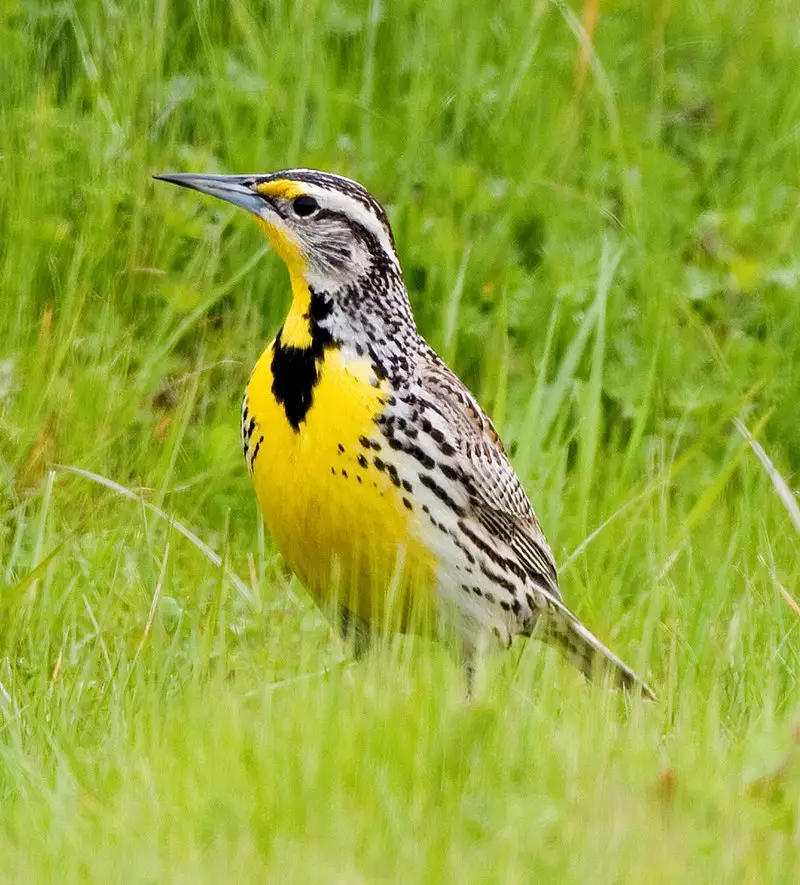
The western meadowlark is a medium-sized icterid bird native to North America. It has a distinct yellow breast with black and white patches, making it easy to spot in open grasslands.
Its diet consists of mostly bugs but also includes seeds and berries. The western meadowlark’s call is unique – its sound described as flute-like or watery, differentiating it from the similar eastern meadowlark species.
When nesting season arrives, they build their nests on the ground near shrubs or low trees in areas like fields and pastures.
This beautiful songbird adds life to our open lands with its melodious tunes.Scientific classification:
| Kingdom | Animalia |
| Phylum | Chordata |
| Class | Aves |
| Order | Passeriformes |
| Family | Icteridae |
| Genus | Sturnella |
| Species | S. neglecta |
Also Featured In: Most Common United States Birds, Birds that Live in the Grasslands
2. Cactus Wren
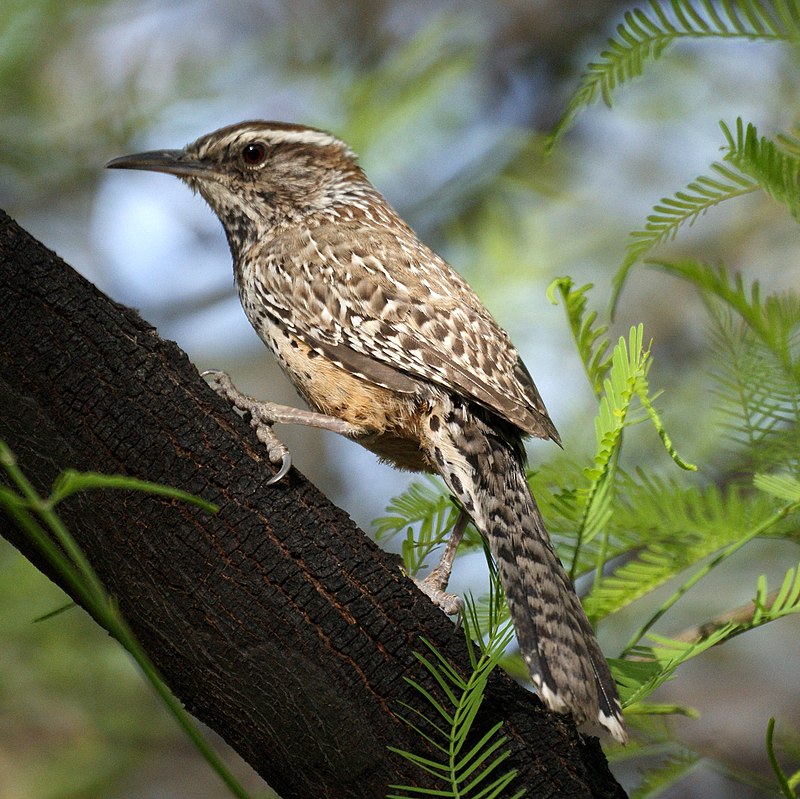
The cactus wren is an enchanting bird found in the deserts of the southwestern United States and northern and central Mexico.
It has a unique brown plumage, with black and white spots as markings, along with a distinctive white eyebrow sweeping to its nape.
Its chest is also snow-white, whereas its belly features light brown bars that contrast nicely against other feathers.
This species holds special significance for Arizona – it was declared their state bird due to its large size compared to other US wrens.
Cactus Wrens are often seen perched atop Saguaro cacti or jumping around on desert ground searching for food such as insects like beetles or spiders.Scientific classification:
| Kingdom | Animalia |
| Phylum | Chordata |
| Class | Aves |
| Order | Passeriformes |
| Family | Troglodytidae |
| Genus | Campylorhynchus |
| Species | C. brunneicapillus |
Also Featured In: Birds that Live in Chaparral, Brown Birds that Found in Texas
3. Peregrine Falcon
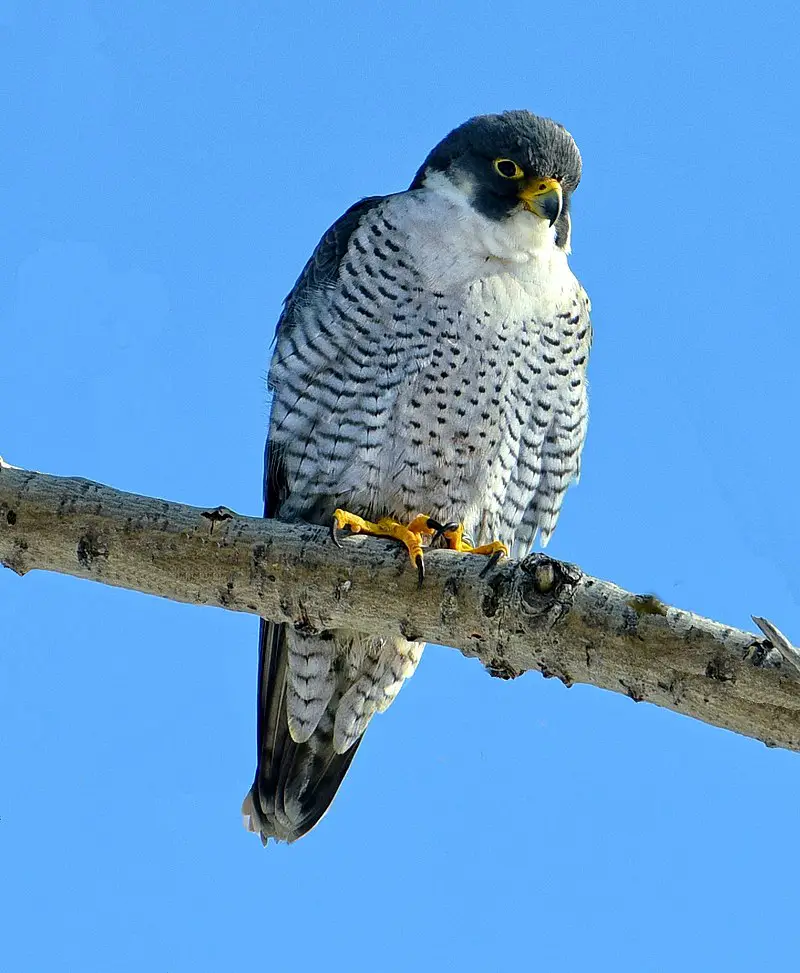
The Peregrine Falcon is a majestic bird of prey belonging to the family Falconidae. It has a blue-grey back, barred white underparts and black head making it easily recognizable.
This intelligent raptor is known for its incredible speed reaching over 320 km/h (200 mph) during hunting dives – one of the fastest animals in existence.
The peregrine falcon can be found around the world from Arctic tundra to tropical rainforests thriving with humans or in high alpine mountains far away from civilization.
With their beauty, power and adaptability they are an impressive species that have earned respect among many cultures throughout history as symbols of strength and endurance.Scientific classification:
| Kingdom | Animalia |
| Phylum | Chordata |
| Class | Aves |
| Order | Falconiformes |
| Family | Falconidae |
| Genus | Falco |
| Species | F. peregrinus |
Also Featured In: Birds of Sweden, Flight Birds You Should Know
4. Greater Roadrunner
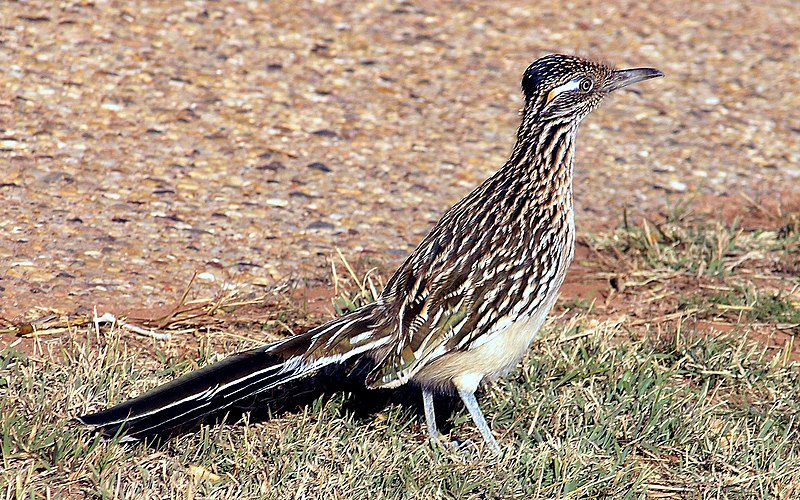
The Greater Roadrunner is a long-legged bird in the Cuculidae family that can be found throughout Aridoamerica. It has many nicknames, including Californian Earth-cuckoo, Chaparral Cock and Snake Killer.
This species is one of two birds belonging to the genus Geococcyx – the other being its smaller counterpart, Lesser Roadrunner.
The Greater Roadrunners are known to eat anything they can catch such as lizards, snakes and insects, making them very valuable predators for keeping pests at bay.
They also have an impressive burst of speed over short distances which helps with hunting prey or escaping danger quickly.
With their large eyes and distinctive black tip on their tail feathers, these amazing creatures make quite an impression when spotted out in nature.Scientific classification:
| Kingdom | Animalia |
| Phylum | Chordata |
| Class | Aves |
| Order | Cuculiformes |
| Family | Cuculidae |
| Genus | Geococcyx |
| Species | G. californianus |
5. Great Horned Owl
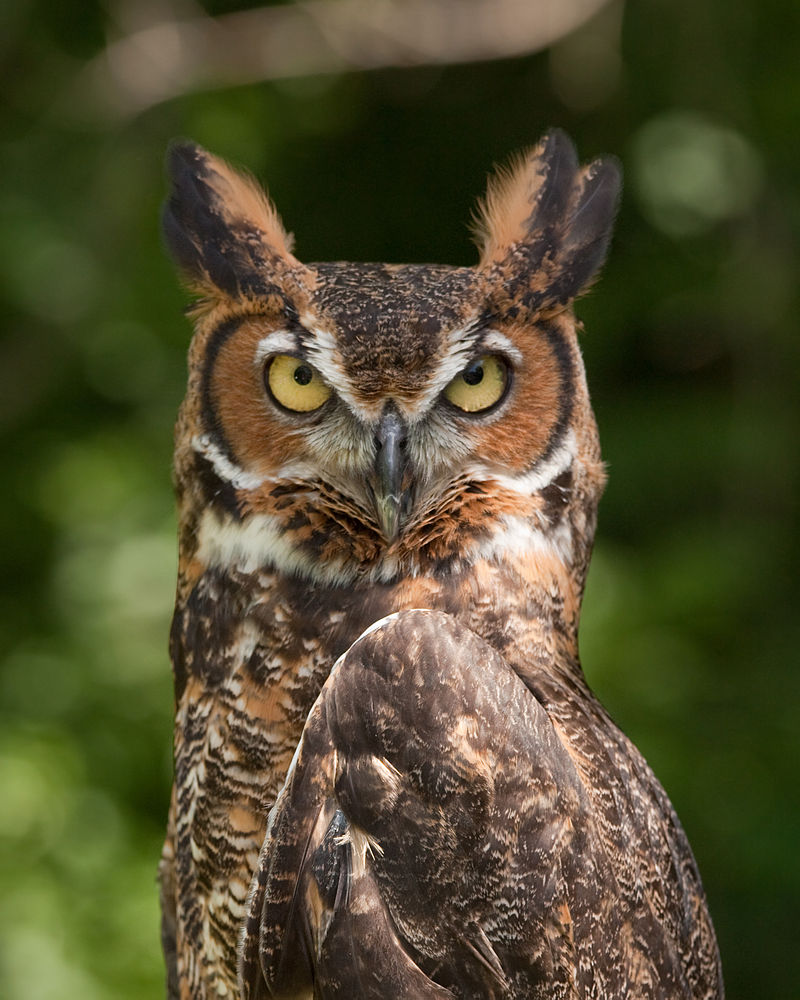
The Great Horned Owl is an impressive bird native to the Americas. It is well-known for its wide range and adaptability, as it can be found in many different habitats across the continent.
Its diet consists primarily of rabbits, hares, rats and mice; however, they are also known to consume skunks, geese and other birds too.
With their powerful talons capable of crushing prey with ease, these owls have earned themselves a fearsome reputation due to their incredible strength.
Their iconic horn-like tufts on either side of its head add another layer of intimidation which helps them stand out from other owls in the area.Scientific classification:
| Kingdom | Animalia |
| Phylum | Chordata |
| Class | Aves |
| Order | Strigiformes |
| Family | Strigidae |
| Genus | Bubo |
| Species | B. virginianus |
Also Featured In: Most Popular Bird Species in North America, Birds Commonly Found in New York
6. Burrowing Owl
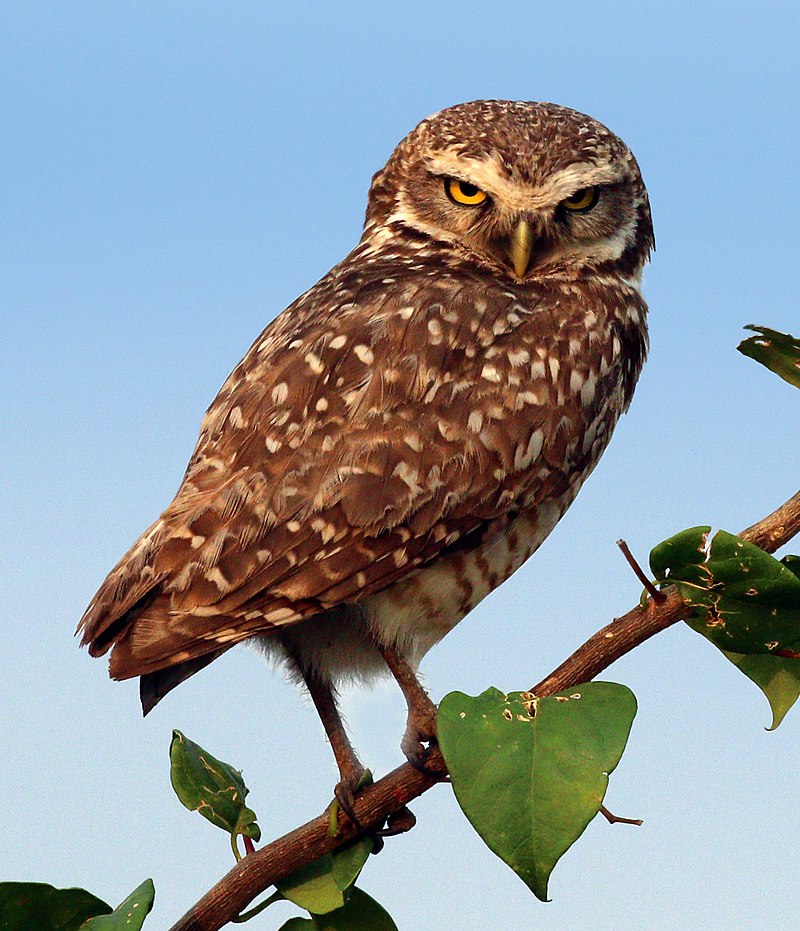
The Burrowing Owl is a small, long-legged owl found in open landscapes throughout North and South America. They are typically seen in grasslands, rangelands, agricultural areas or deserts with low vegetation.
Unlike most owls they nest and roost underground by taking over burrows made by other animals such as prairie dogs.
Their diet consists of insects, rodents and sometimes lizards or frogs that they hunt during the night time hours when their eyesight is sharpest.
This species faces threats due to habitat loss caused by human development but conservation efforts have been successful at reversing some of this damage allowing for populations to remain stable into the future despite these pressures.Scientific classification:
| Kingdom | Animalia |
| Phylum | Chordata |
| Class | Aves |
| Order | Strigiformes |
| Family | Strigidae |
| Genus | Athene |
| Species | A. cunicularia |
Also Featured In: Beautiful Brazilian Birds, Birds that Live around Southwest Florida
7. White-Winged Dove
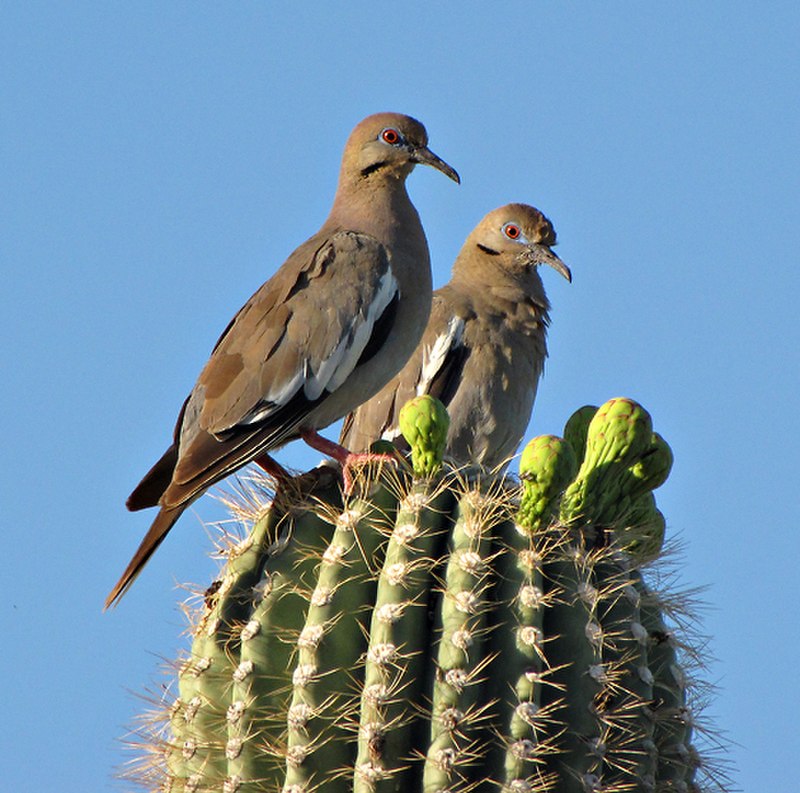
The White-winged Dove is an impressive bird with a large body and wingspan. Its distinctive feature is the white edge on its wings, which makes it easily recognizable when in flight.
It has blue eyerings, red eyes and gray plumage, while juveniles are duller in coloration than adults.
This dove species inhabits areas from Southwestern United States through Mexico to Central America as well as Caribbean islands.
They usually live close to human settlements or cities but can also be found in agricultural fields feeding on grains like corn or wheat seeds left by farmers after harvest season ends.
In their natural habitat they feed primarily on insects, fruits and small plants such as certain cacti species.Scientific classification:
| Kingdom | Animalia |
| Phylum | Chordata |
| Class | Aves |
| Order | Columbiformes |
| Family | Columbidae |
| Genus | Zenaida |
| Species | Z. asiatica |
Also Featured In: Top Birds Found in Mexico, Central Texas Birds
8. Loggerhead Shrike
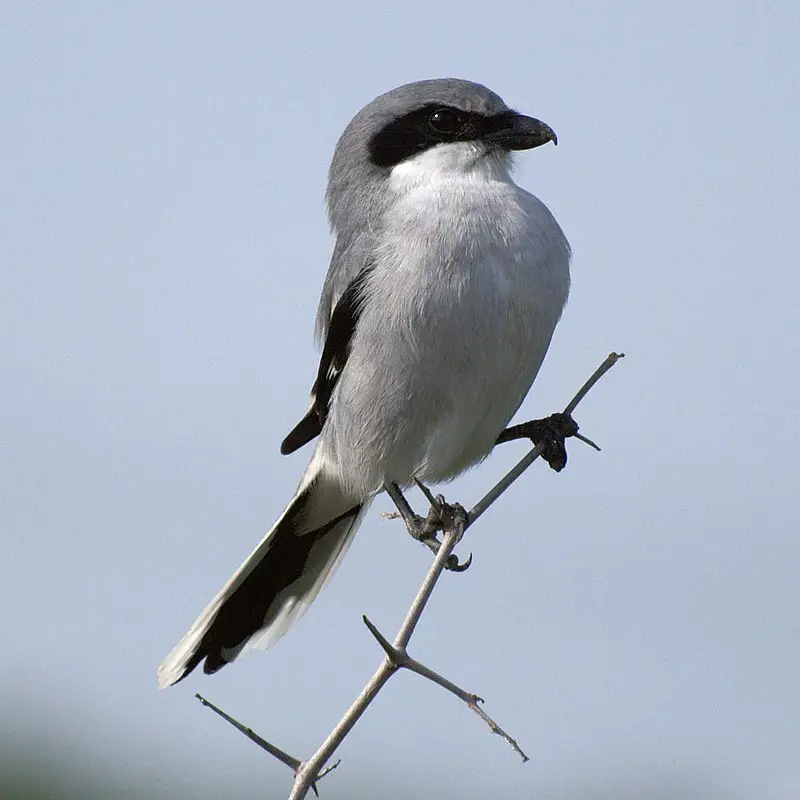
The Loggerhead Shrike is a carnivorous bird found only in North America. It belongs to the family Laniidae and is known as the “butcherbird” because of its habit of catching prey, such as amphibians, insects, lizards and small mammals.
The shrike has a black mask around its eyes and grey wings with white patches on them.
Its back is black with white spots that resemble stars or snowflakes; some individuals may have brown feathers instead of black ones.
This species feeds mainly by perching from elevated locations like bushes or trees where it can spot potential meals below it before diving down for capture.
Interestingly enough, these birds are also known to store their food by impaling it onto thorns which they use later when hungry.
With less than 2 million estimated population left in wild today this species needs our help so we should do whatever we can to protect them better.Scientific classification:
| Kingdom | Animalia |
| Phylum | Chordata |
| Class | Aves |
| Order | Passeriformes |
| Family | Laniidae |
| Genus | Lanius |
| Species | L. ludovicianus |
Also Featured In: Birds Live in Arkansas, Common Birds of Prairie
9. Bewick’s Wren
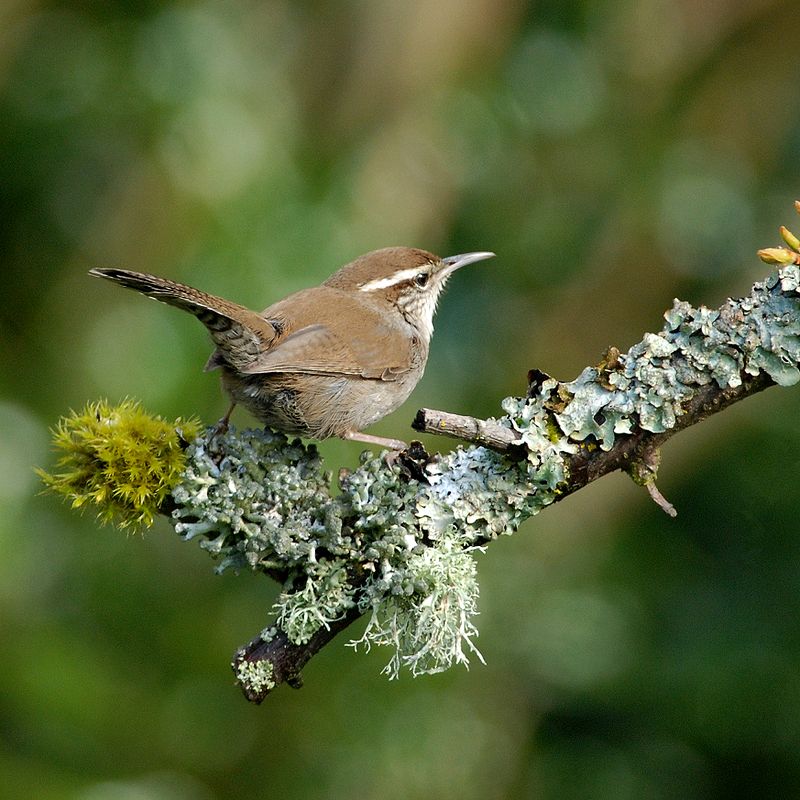
The Bewick’s wren (Thryomanes bewickii) is a small, grey-brown bird native to North America. Measuring at around 14 cm long it has distinctive white markings on its face and tail giving it an attractive appearance.
It can often be found in thickets or scrubby areas as well as urban gardens and parks.
Its song is loud and melodious which makes them popular amongst ornithologists; they are known for their complex vocalisations composed of whistles, clicks, churrs and trills.
The Bewick’s Wren mainly feeds on insects but will also eat fruits if available during the colder months when food may otherwise be scarce.
This species of wren plays an important role in controlling insect populations making them beneficial inhabitants of our environment.Scientific classification:
| Kingdom | Animalia |
| Phylum | Chordata |
| Class | Aves |
| Order | Passeriformes |
| Family | Troglodytidae |
| Genus | Thryomanes P.L. Sclater, 1862 |
| Species | T. bewickii |
Also Featured In: Birds That Live around Seattle, Birds in Pacific Northwest
10. Canyon Towhee
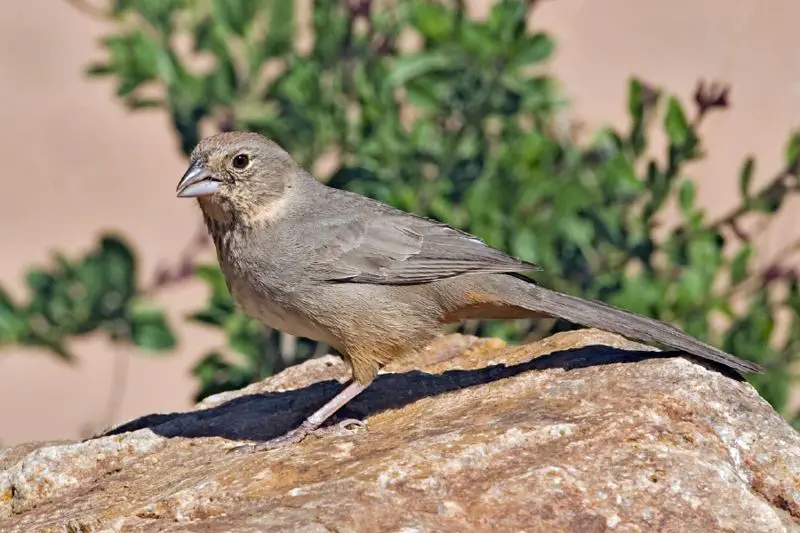
The Canyon Towhee is a small bird belonging to the Passerellidae family. It has an olive-brown head and back, with a greyish white belly and chest. The wings are darker than the body, while its tail feathers are brown in color.
This species resides near dry canyons, hence their name; however it inhabits other woodlands as well. Its diet consists of seeds, fruits, insects and some grasses too.
They generally forage or search for food on ground level but also occasionally pick up food from tree branches or shrubs as well.
During breeding season they engage in courtship displays by bowing low with spread tails that vibrate rapidly before taking flight into the air singing songs all along.Scientific classification:
| Kingdom | Animalia |
| Phylum | Chordata |
| Class | Aves |
| Order | Passeriformes |
| Family | Passerellidae |
| Genus | Melozone |
| Species | M. fusca |
Also Featured In: Most Common Birds of Nuevo Leon, Common Birds of Mexico City
11. Lesser Goldfinch
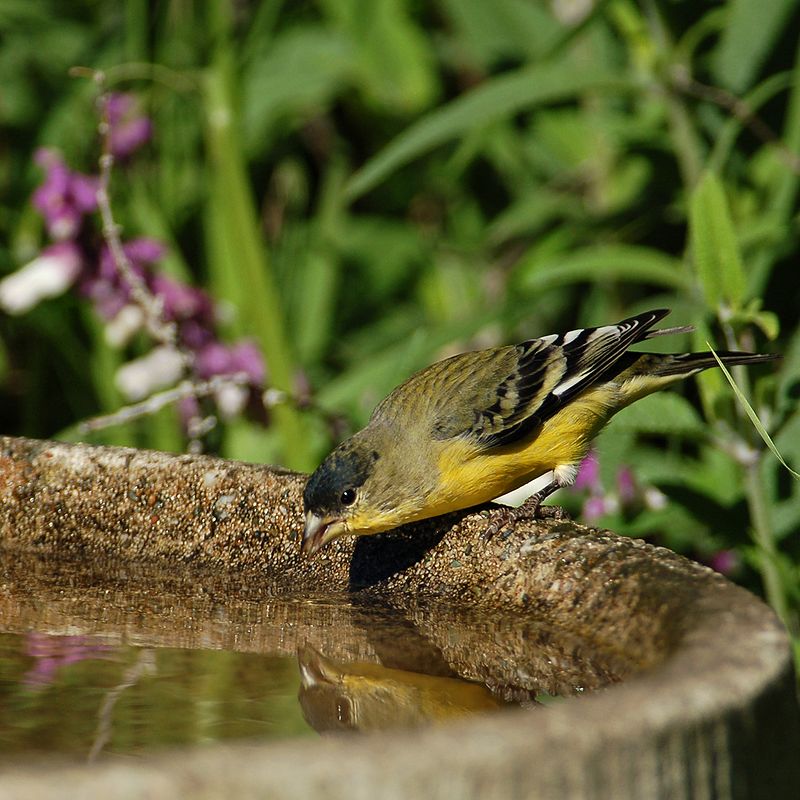
The Lesser Goldfinch is a tiny species of bird found in the Americas. It belongs to the same clade as American goldfinches and Lawrence’s goldfinches, which can be identified by their males having black or rarely green foreheads.
The face appears red or yellow on these birds unlike other species in its genus Spinus sensu stricto.
They are small songbirds with short bills, brown wings and tails with white edges, grey-brown backs and olive heads.
These birds inhabit open woodlands and fields where they feed mainly on seeds from weeds such as thistle, pigweed and ragweed but also consume insects at times during breeding season for additional nutrition.
In addition to being an important part of North America’s avian ecology, these birds have been popularized through recent artwork depicting them in various poses among flowers.Scientific classification:
| Kingdom | Animalia |
| Phylum | Chordata |
| Class | Aves |
| Order | Passeriformes |
| Family | Fringillidae |
| Subfamily | Carduelinae |
| Genus | Spinus |
| Species | S. psaltria |
Also Featured In: Birds that Live in San Francisco Bay Area, Birds that Live in Yosemite National Park
12. Turkey Vulture
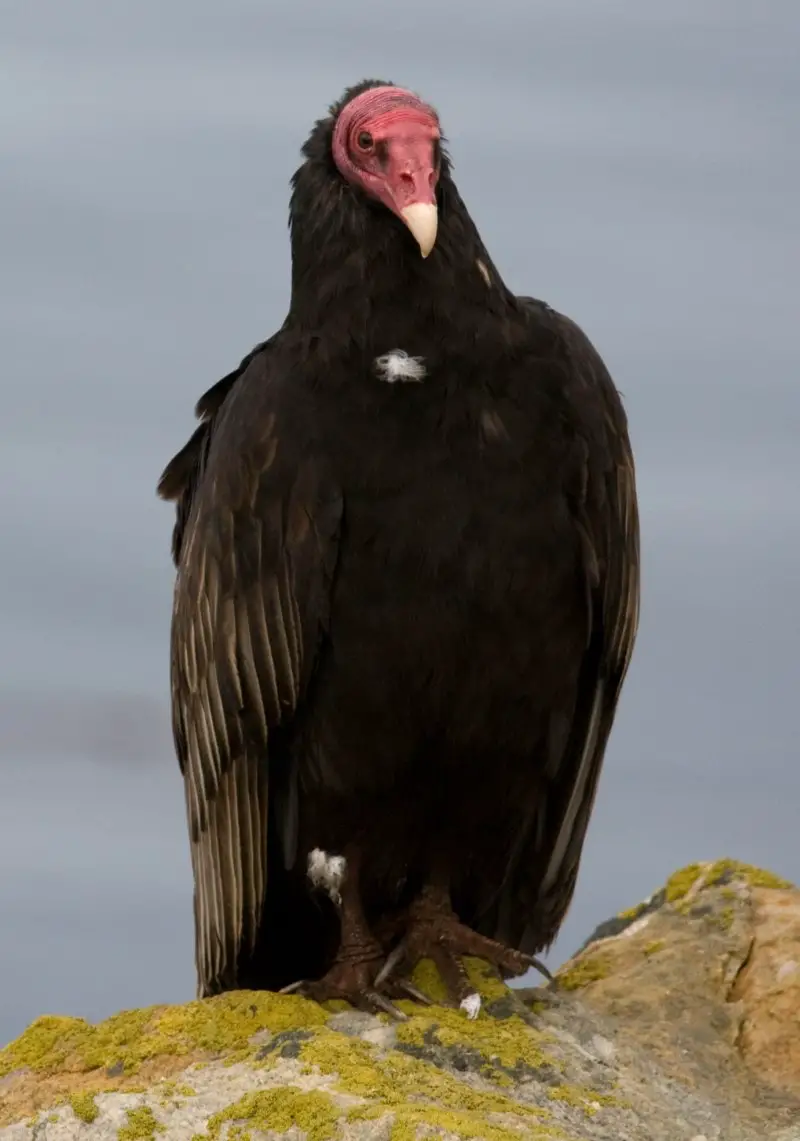
The turkey vulture is a large bird of prey that can be found in many parts of the world. It has a wingspan of up to 6 feet and its feathers are mostly black with brownish-red patches on the underside which give it an overall dark red appearance.
Its head is bald, which helps protect it from getting overheated when flying long distances looking for food.
The Turkey Vulture usually feeds off carrion but will also feed on fruit and insects.
Its keen eyesight allows them to spot potential meals from miles away while they soar through the sky using their broad wings and thermal air currents to stay aloft without expending much energy.
They are very important scavengers as they keep ecosystems healthy by consuming dead animals before disease can spread amongst living creatures or contaminate local water sources like rivers or lakesScientific classification:
| Kingdom | Animalia |
| Phylum | Chordata |
| Class | Aves |
| Order | Accipitriformes |
| Family | Cathartidae |
| Genus | Cathartes |
| Species | C. aura |
Also Featured In: Turkey Birds You Should Know, Birds You’ll Find in Zoo
13. Tyrant Flycatchers
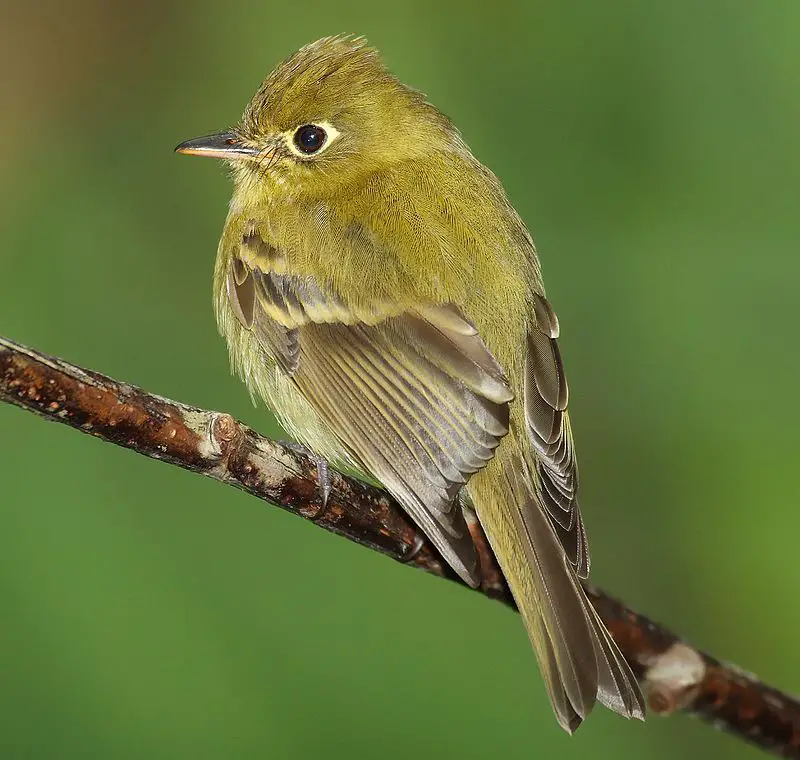
Tyrant flycatchers are a family of birds found in North and South America, containing over 400 species. These birds come in an array of shapes and sizes, with vibrant plumage to match.
They�re the most diverse avian family across all countries they inhabit except for the United States and Canada.
Their diet consists mainly of insects but also includes small reptiles or amphibians where available.
The behavior varies between each bird; some prefer open areas while others like dense forests as their habitat � many even migrate regularly.
Tyrant Flycatchers have adapted well to human presence thanks to the abundance of food sources that often accompany it � such as backyards, parks etc..
All things considered these incredible creatures are truly amazing.Scientific classification:
| Kingdom | Animalia |
| Phylum | Chordata |
| Class | Aves |
| Order | Passeriformes |
| Parvorder | Tyrannida |
| Family | Tyrannidae Vigors, 1825 |
Also Featured In: Birds of Argentina, Birds that You’ll Find in Puerto Rico
14. Red-Tailed Hawk
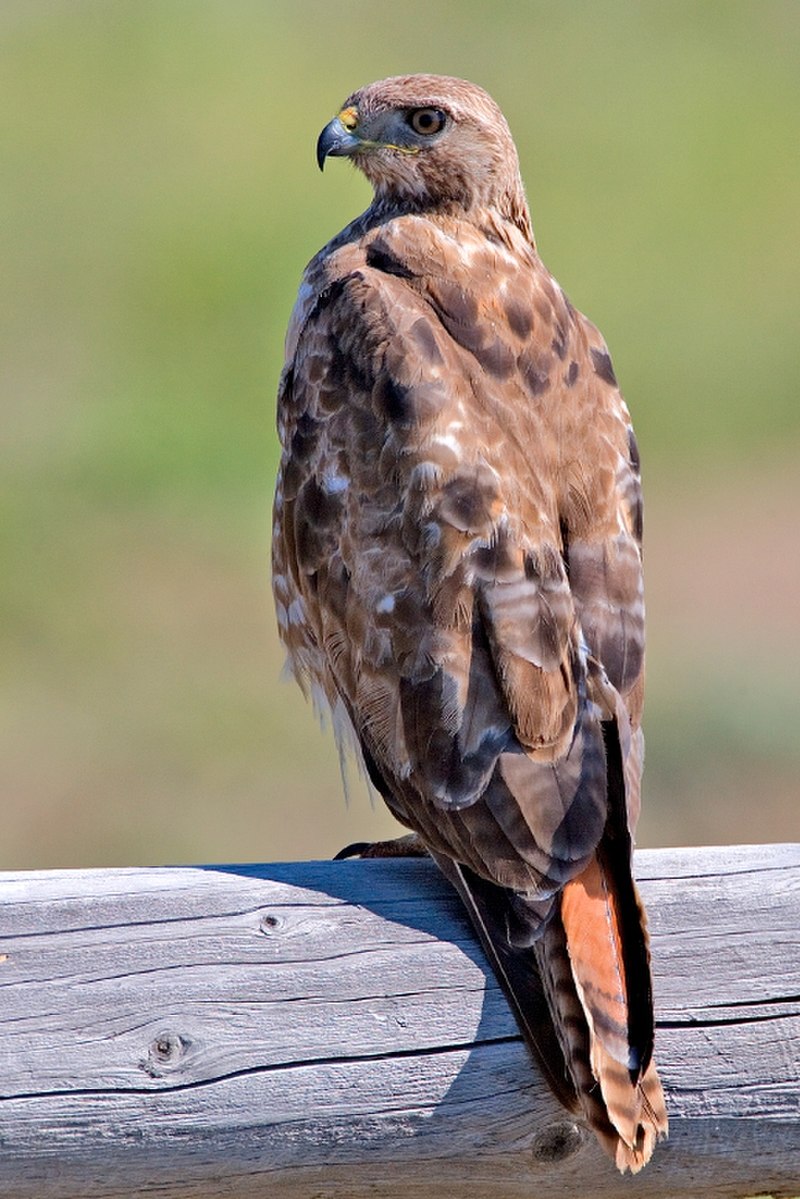
The Red-tailed Hawk is a majestic bird of prey with its distinctive red tail. It can be found throughout North America, from Alaska in the north to Panama and the West Indies in the south.
This species belongs to Buteo genus, which makes it one of most common raptors on earth.
These hawks mainly hunt small mammals such as rabbits or squirrels but also feed on reptiles and birds during migration season.
Unlike other predator birds, they prefer open areas for hunting like fields or grasslands rather than dense forests.
They build their nests high up on trees where they stay all year long unless disturbed by humans or animals nearby.
Their presence has become an iconic part of American culture due to their frequent sightings around homes and parks alike making them beloved creatures among people everywhere.Scientific classification:
| Kingdom | Animalia |
| Phylum | Chordata |
| Class | Aves |
| Order | Accipitriformes |
| Family | Accipitridae |
| Genus | Buteo |
| Species | B. jamaicensis |
Also Featured In: Dominican Republic birds, New Hampshire Birds You Should Know
15. Ferruginous Pygmy Owl
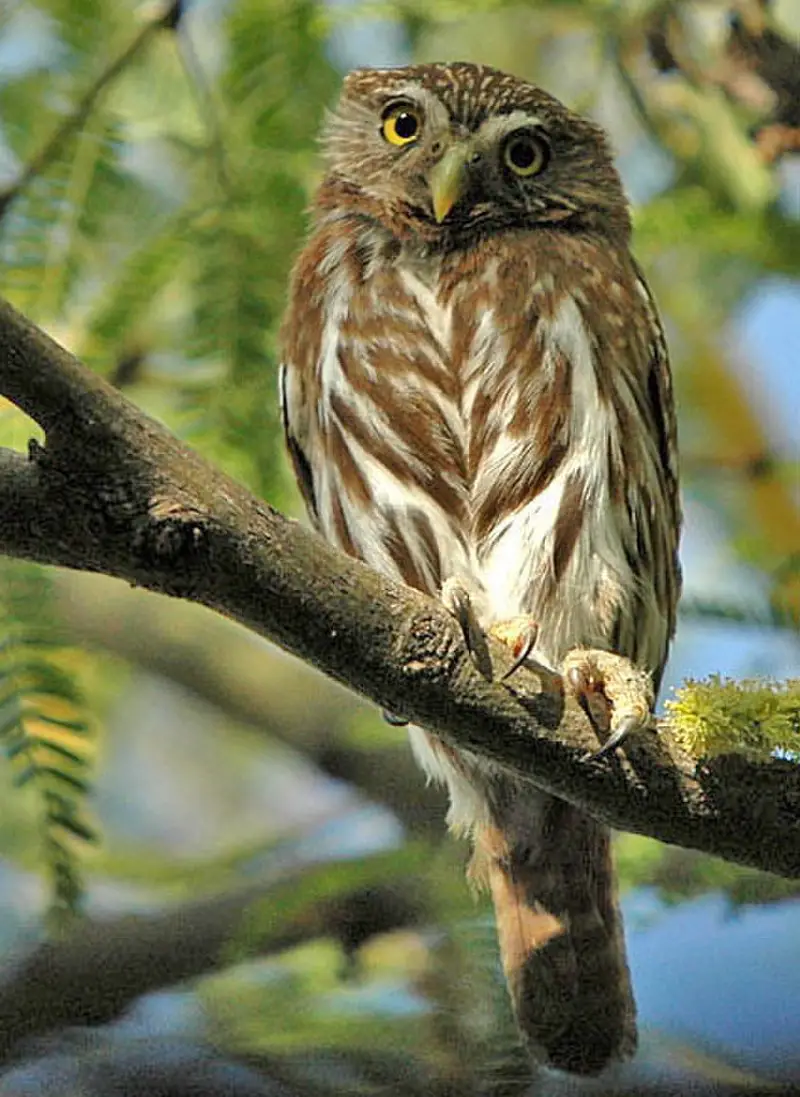
The ferruginous pygmy owl is a small species of owl that can be found throughout much of Central and South America, as well as parts of the United States.
It has rusty-brown feathers on its body, giving it an overall “ferruginous” colouration. The bird feeds mainly on insects and other invertebrates, but also eats some larger prey such as lizards or mice when available.
During breeding season the birds build nests in tree cavities to raise their young. They are usually nocturnal creatures but may become active during daylight hours if disturbed by humans or predators nearby.
This adaptable little raptor is often seen perching atop buildings or street lights in urban areas where they have adapted to live alongside human activity while still finding food sources within cities and townships alike.Scientific classification:
| Kingdom | Animalia |
| Phylum | Chordata |
| Class | Aves |
| Order | Strigiformes |
| Family | Strigidae |
| Genus | Glaucidium |
| Species | G. brasilianum |
Also Featured In: Uruguay birds,
16. Black-Tailed Gnatcatcher
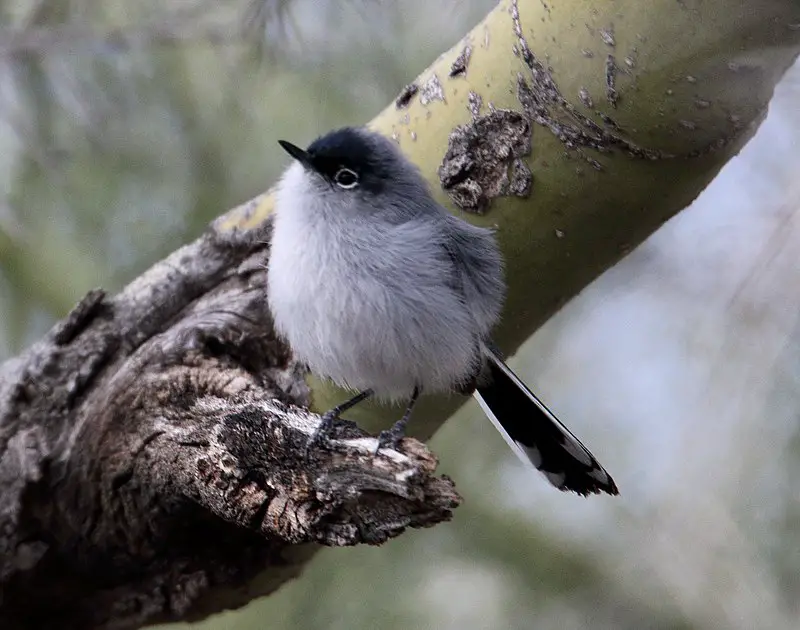
The Black-tailed Gnatcatcher is a small, insectivorous bird found in the Sonoran and Chihuahuan Deserts of North America. These birds do not migrate and can be seen year round in dry desert areas.
Described by American ornithologist George Newbold Lawrence in 1857, its scientific name (Polioptila melanura) translates to ‘black-tailed’.
It has an overall grayish brown plumage with white wingbars, black tail feathers, a long slender bill for catching insects on the fly and pale eyes lined with dark markings .
They are vocal birds that produce melodious song including trills, warbles and whistles often heard during breeding season from May through August.
The diet consists mainly of various insects such as flies , moths , beetles as well bugs which help control pest populations naturally making it an important species for our eco system.Scientific classification:
| Kingdom | Animalia |
| Phylum | Chordata |
| Class | Aves |
| Order | Passeriformes |
| Family | Polioptilidae |
| Genus | Polioptila |
| Species | P. melanura |
Also Featured In: Chickadees Birds, Birds that Live in the Deserts
17. Prairie Falcon
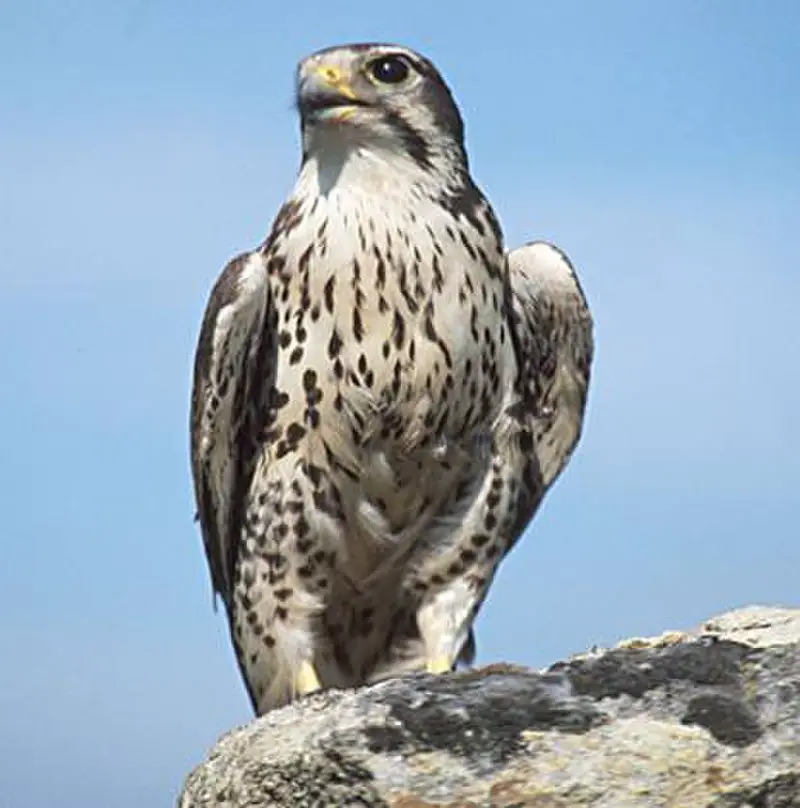
The Prairie Falcon is a distinct species of medium-large sized falcon found in western North America. It has an average length of 40cm, wingspan of 1 meter and weighs around 720g.
Females tend to be larger than males typical for all falcons.
Although separate from the Peregrine Falcon, they share many similarities such as similar coloring on their back and shoulders with dark spots on light brown feathers which helps them blend into the environment while hunting prey like small birds or rodents over open areas like grasslands or deserts.
They are also known to fly extremely fast reaching speeds up to 80 miles per hour.Scientific classification:
| Kingdom | Animalia |
| Phylum | Chordata |
| Class | Aves |
| Order | Falconiformes |
| Family | Falconidae |
| Genus | Falco |
| Species | F. mexicanus |
Also Featured In: Falcons Species, Common Birds in Alberta
18. Say’s Phoebe
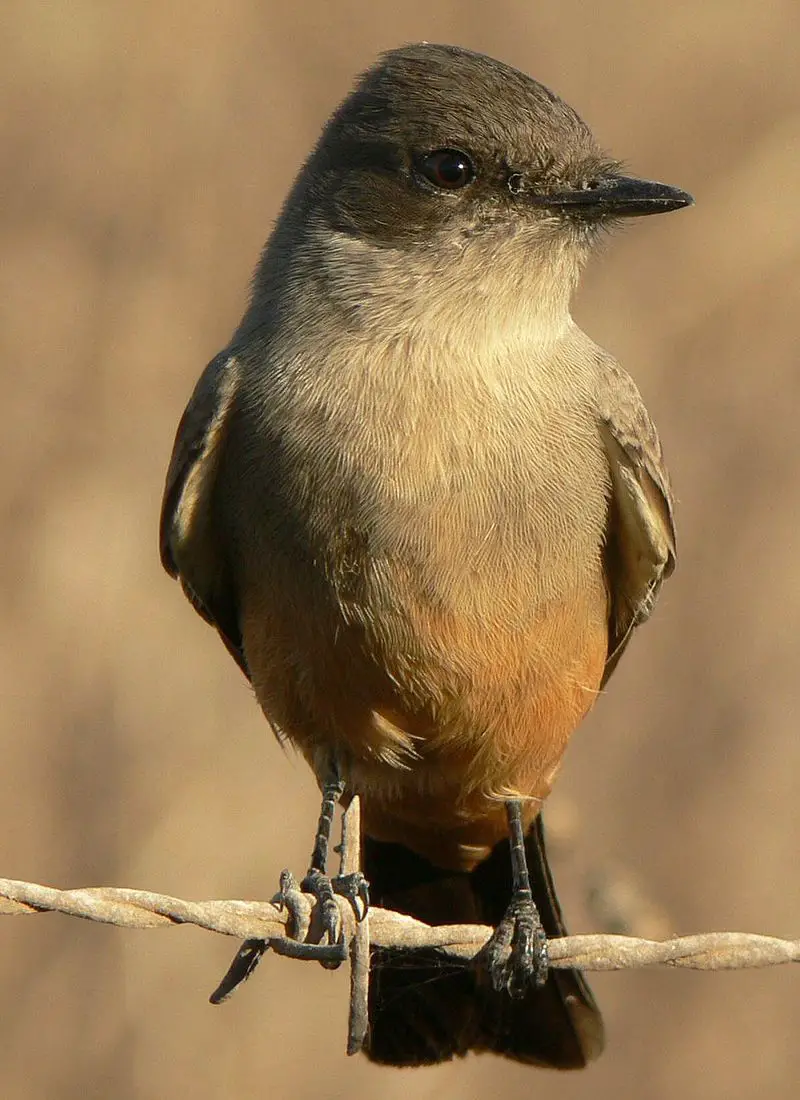
Say’s phoebe is a bird from the tyrant flycatcher family native to western North America. It was named for American naturalist Thomas Say, who first described it in 1825.
This species prefers dry and desolate areas as its habitat. Its brown plumage with whitish underside makes them quite easy to spot among other birds of similar size.
They are also known for their distinctive call; “phoe-bee” which they repeat often throughout the day while perched on fence posts or tree branches scanning their surroundings looking out for food sources such as flying insects, small frogs and lizards etc..
Their nests are made up of plant materials like grasses lined with hair or feathers placed inside cavities either under overhangs or in abandoned structures like barns and sheds providing ample protection against predators such as hawks and foxes.Scientific classification:
| Kingdom | Animalia |
| Phylum | Chordata |
| Class | Aves |
| Order | Passeriformes |
| Family | Tyrannidae |
| Genus | Sayornis |
| Species | S. saya |
Also Featured In: Flycatchers Species, Phoenix Birds You Should Know
19. Western Kingbird
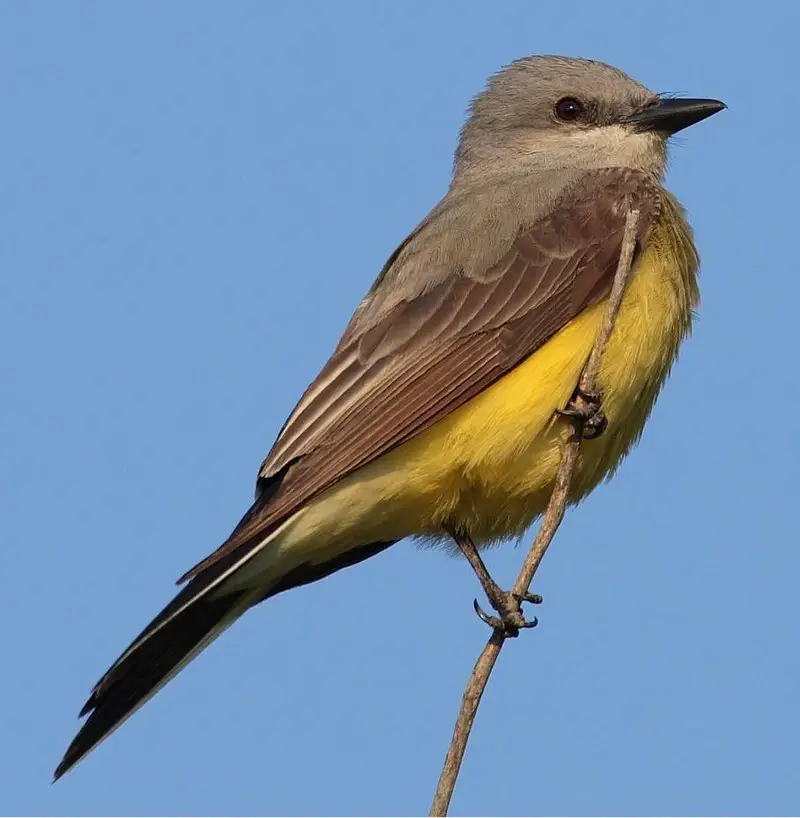
The Western kingbird is a large tyrant flycatcher native to western North America. It has striking plumage, with gray and yellow feathers tinged with crimson during courtship or when defending territory from intruders.
As is characteristic of its kind, the Western Kingbird exhibits highly territorial behavior towards other birds in its area.
They are found as far south as Mexico, inhabiting open habitats near bodies of water such as rivers and lakes.
While their primary diet consists of insects like bees and flies that they catch mid-flight, it also includes fruit for variety during winter months.
The species have recently seen an increase in population due to conservation efforts which aim to protect these beautiful creatures.Scientific classification:
| Kingdom | Animalia |
| Phylum | Chordata |
| Class | Aves |
| Order | Passeriformes |
| Family | Tyrannidae |
| Genus | Tyrannus |
| Species | T. verticalis |
Also Featured In: Common Southern Californian Birds, Summer Birds that Live around Us
20. Black Phoebe
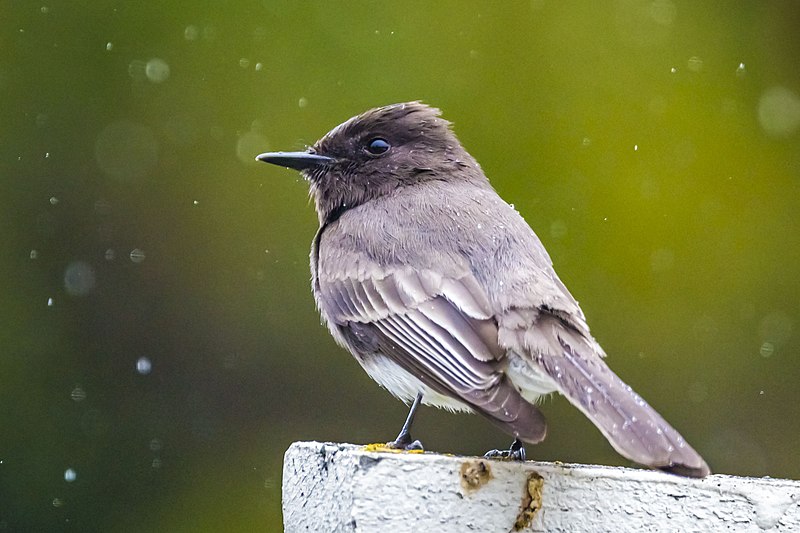
The black phoebe is a beautiful passerine bird belonging to the tyrant-flycatcher family. It breeds from southwest Oregon and California south through Central and South America, where it can be found year-round.
However, its northern populations tend to migrate seasonally in some areas. Six subspecies of this species have been identified so far: two are occasional visitors while the others are more common residents in their range.
The adult has mainly dark grey upperparts with a white belly; juveniles may show brownish tones instead of grey ones on their back.
Its main diet consists of insects which it catches by hovering over water or flying out after them from perches near rivers or streams – hence why they’re often seen around these places.Scientific classification:
| Kingdom | Animalia |
| Phylum | Chordata |
| Class | Aves |
| Order | Passeriformes |
| Family | Tyrannidae |
| Genus | Sayornis |
| Species | S. nigricans |
Also Featured In: Birds Live Near San Diego, Birds Commonly Found in Northern California
21. Scarlet Flycatcher
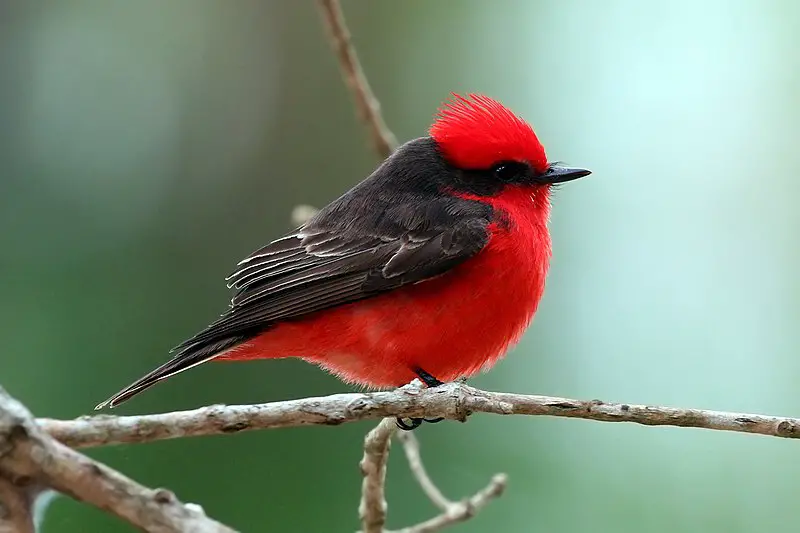
The Scarlet Flycatcher, also referred to as the Austrial Vermilion Flycatcher, is an eye-catching bird found in southeastern Bolivia and Brazil, Paraguay to Argentina and Uruguay.
It belongs to a group of flycatchers closely related with the vermilion flcyatcher. This species has bright orange feathers on its face and chest combined with black wings making it unmistakable when seen up close.
Its diet consists of insects which they catch while flying low over open terrain like creeks or marshes using their agile flight capabilities.
While some taxonomic authorities recognize this bird as a separate species from the Vermillion Flyctacher, others still consider it simply a subspecies thereof.
Overall they are very beautiful birds that will add beauty wherever spotted.Scientific classification:
| Kingdom | Animalia |
| Phylum | Chordata |
| Class | Aves |
| Order | Passeriformes |
| Family | Tyrannidae |
| Genus | Pyrocephalus |
| Species | P. rubinus |
Also Featured In: Spiritual Birds, Red birds You’ll See in Arizona
22. Costa’s Hummingbird
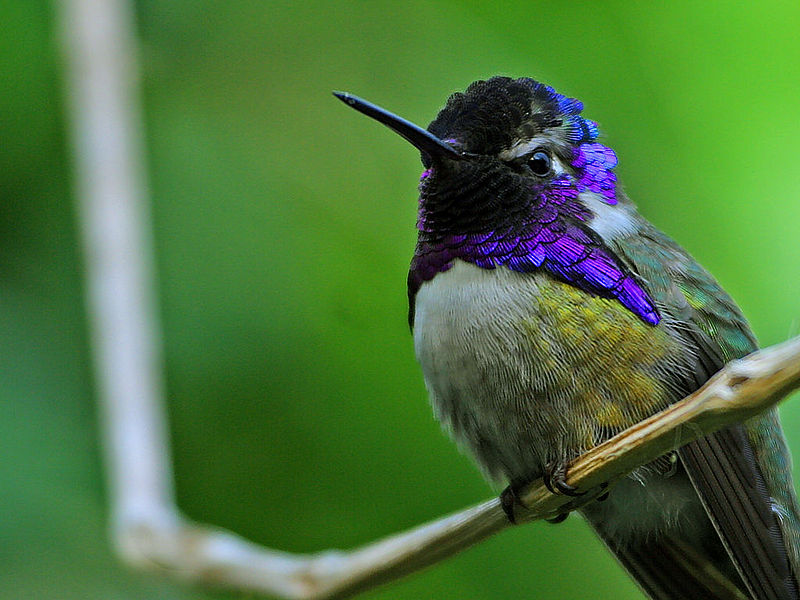
Costa’s hummingbird is a species of the Trochilidae family. It inhabits arid regions in both the southwest United States and northwest Mexico, migrating to western Mexico for wintering purposes.
This bird was named by French ornithologist Jules Bourcier in 1839 after honouring François Coste, who had sent specimens to him from North America.
Costa’s hummingbirds are small birds averaging 3-3.5 inches (7–9cm) long with typically green feathers on their back and tail while underparts are usually greyish or sometimes white with purple highlights around throat area giving them an iridescent appearance when light hits it right angle.
Males also have red patches on forehead which they use as part of courtship display behavior along with singing distinctive “wheep” sound during mating season.Scientific classification:
| Kingdom | Animalia |
| Phylum | Chordata |
| Class | Aves |
| Order | Apodiformes |
| Family | Trochilidae |
| Genus | Calypte |
| Species | C. costae |
Also Featured In: Hummingbirds Species, Orange County Birds You Need to See
23. Lucifer Sheartail
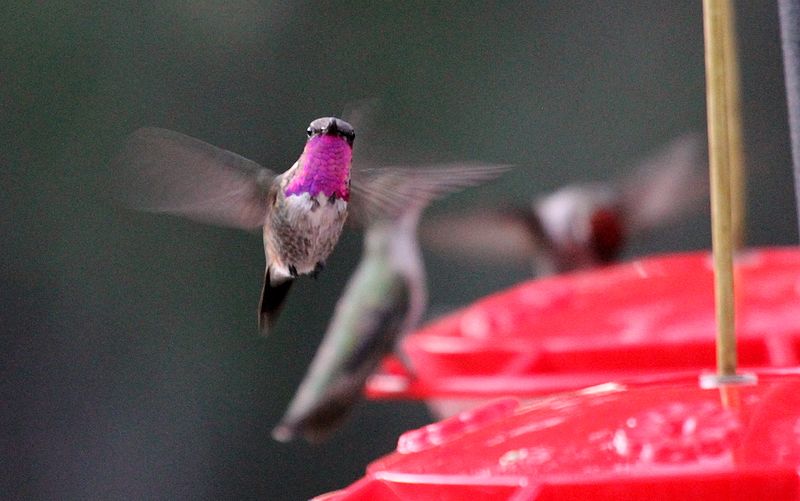
The Lucifer Sheartail is a stunning green hummingbird found in the high-altitude areas of northern Mexico and southwestern United States.
It measures around 10 cm long and has a slightly curved bill with distinctive outward flare of its gorget feathers.
During winter, it migrates to central Mexico for warmer climate. This bird feeds on nectar from flowers as well as small insects which provide protein necessary for growth.
Its vibrant colors make it easily recognizable among other birds, adding beauty to its natural surroundings.Scientific classification:
| Kingdom | Animalia |
| Phylum | Chordata |
| Class | Aves |
| Order | Apodiformes |
| Family | Trochilidae |
| Genus | Calothorax |
| Species | C. lucifer |
24. Western Screech Owl
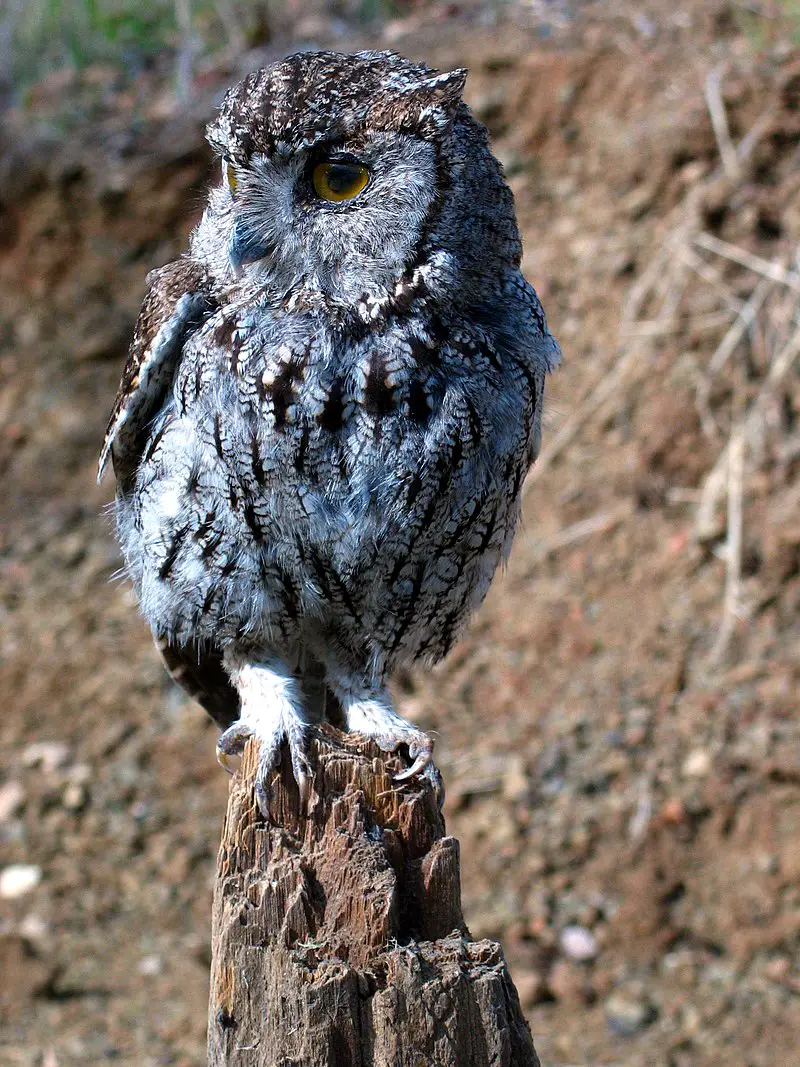
The Western Screech Owl is a small bird native to both North and Central America. It belongs to the same family as its Eastern counterpart, standing at an average of 22 cm tall with 55 cm wingspan and weighing about 143 g.
Females tend to be larger than males, while weight can range from 88-220g depending on habitats in Northern populations being heavier than those living further south.
The scientific name for this owl pays homage to American naturalist Robert Kennicott who studied these birds extensively during his life’s work.
Their diet mostly consists of invertebrates such as insects but they may also hunt small mammals when food sources are scarce or seasonally available.
Their habitat preferences vary across different parts of their geographical range due mainly to environmental conditions like climate and vegetation type.Scientific classification:
| Kingdom | Animalia |
| Phylum | Chordata |
| Class | Aves |
| Order | Strigiformes |
| Family | Strigidae |
| Genus | Megascops |
| Species | M. kennicottii |
Also Featured In: Owls Species, Birds You’ll Find in Night
25. Elf Owl
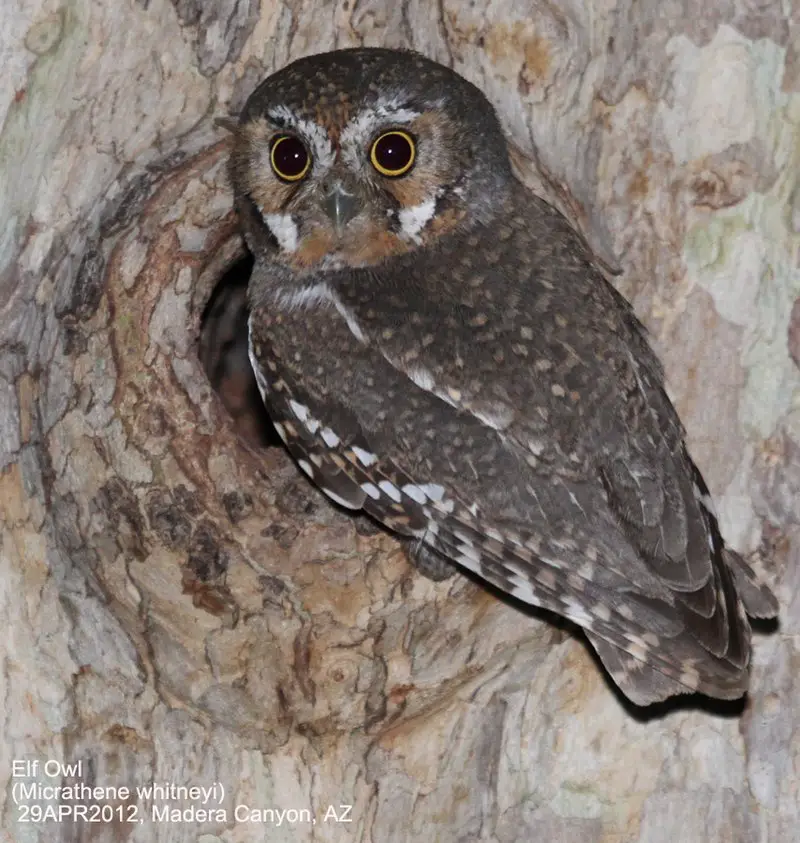
The Elf Owl is a small and fascinating bird. It’s grayish-brown in color, with pale yellow eyes that are highlighted by thin white “eyebrows” and a gray bill with a horn-colored tip.
This owl can be found throughout the Southwestern United States, central Mexico, and the Baja California peninsula.
These birds often take up residence in woodpecker holes inside saguaro cacti or natural tree cavities.
They’re nocturnal hunters who feed mainly on insects as well as other small prey such as lizards or rodents.
Despite their size they have impressive vocalizations that include whistles and harsh cries which helps them to communicate within their range during breeding season; however it also serves to alert predators of its presence.Scientific classification:
| Kingdom | Animalia |
| Phylum | Chordata |
| Class | Aves |
| Order | Strigiformes |
| Family | Strigidae |
| Genus | Micrathene Coues, 1866 |
| Species | M. whitneyi |
Also Featured In: Birds You’ll Find in Sonoran,
26. Black-Throated Sparrow
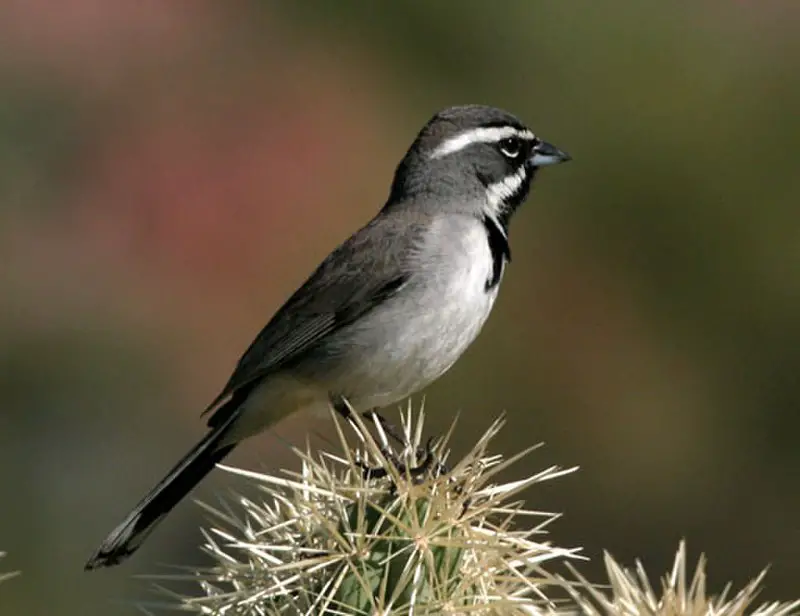
The black-throated sparrow is a small bird native to the southwestern United States and Mexico.
It is known for its striking features, including black throats with white stripes on either side as well as buffy, white underparts.
They are also recognized by their long tails and dark upper parts, which often have yellowish or rusty markings near the wings.
The birds prefer arid habitats such as deserts and scrublands; however they can be found in other areas too during migration periods.
These adaptable creatures feed on insects, seeds and grains from plants like grasses or cacti – making them an important species when it comes to sustaining healthy ecosystems.Scientific classification:
| Kingdom | Animalia |
| Phylum | Chordata |
| Class | Aves |
| Order | Passeriformes |
| Family | Passerellidae |
| Genus | Amphispiza Coues, 1874 |
| Species | A. bilineata |
Also Featured In: Sparrows Species,
27. Brewer’s Sparrow
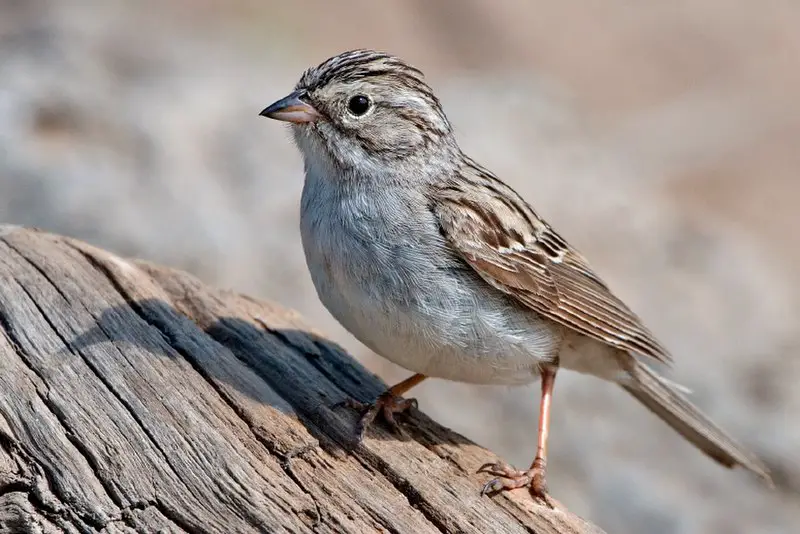
The Brewer’s Sparrow is a small, slim sparrow native to North America. It has grey-brown upperparts with dark streaks on its crown and pale eye-rings.
Its wings are brown with light bars, while the underparts are pale grey in color.
The bill is mostly pale but tipped in dark colors and it has long tail feathers which help it maneuver through dense vegetation easily.
This bird was named after ornithologist Thomas Mayo Brewer for his contributions to bird study during the 19th century.
During winters they gather together in large flocks often seen perched atop tall shrubs or trees singing their distinct songs of “seet seet” or “tisi tsi” throughout the day as they search for food amongst thickets of grasses and other vegetation coverings near wetlands that provide necessary sustenance over winter months when insect populations diminish significantly due to cold temperatures prevailing outside at night time hours.Scientific classification:
| Kingdom | Animalia |
| Phylum | Chordata |
| Class | Aves |
| Order | Passeriformes |
| Family | Passerellidae |
| Genus | Spizella |
| Species | S. breweri |
28. Gila Woodpecker
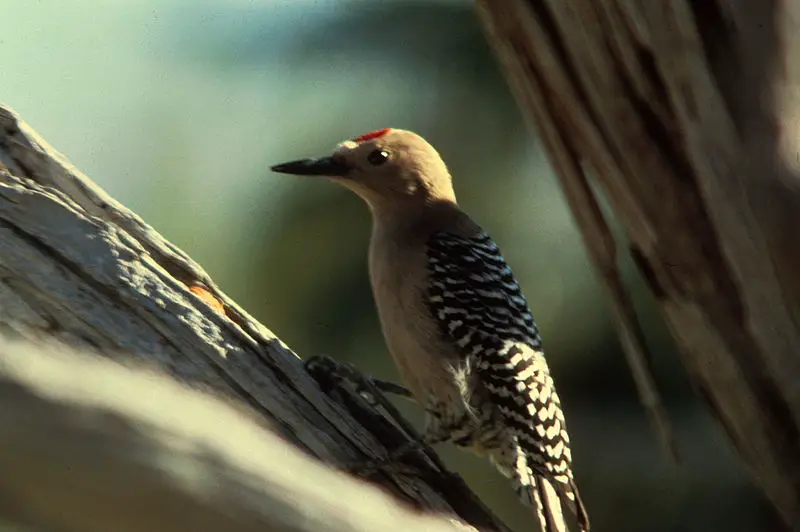
The Gila woodpecker is a medium-sized bird found in the desert regions of the southwestern United States and western Mexico.
It has a unique coloration, featuring black and white zebra-like stripes on its back, wings, and tail feathers.
Its neck, throat belly and head are greyish tan in color with small red or yellow spots on its nape.
They feed mainly on insects but have been known to eat berries when available during winter months.
These birds are social creatures that often nest together in large colonies to increase their chances of survival against predators such as hawks or owls.
The Gila woodpecker plays an important role in maintaining healthy ecosystems by eating destructive beetles while also spreading seeds from cacti they consume throughout the year.Scientific classification:
| Kingdom | Animalia |
| Phylum | Chordata |
| Class | Aves |
| Order | Piciformes |
| Family | Picidae |
| Genus | Melanerpes |
| Species | M. uropygialis |
Also Featured In: Woodpeckers Species,
29. Gilded Flicker
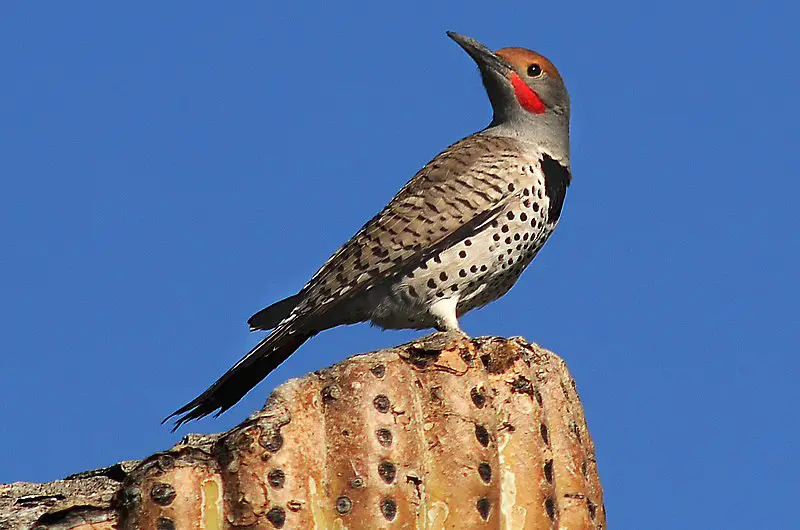
The Gilded Flicker is an impressive and striking bird that can be found in the desert regions of Southwestern United States and Northwestern Mexico.
It has a mean length of 29 cm (11 inches) which makes it one of the largest woodpeckers.
Its distinguishing feature is its golden-yellow underwings, making it stand out from other species such as the northern flicker in these areas.
This majestic bird mainly consumes insects but may also feed on fruits or berries when available, helping to spread seeds throughout their habitats.
As they are not migratory birds, they remain all year round; hence providing some stability to their local ecosystems.Scientific classification:
| Kingdom | Animalia |
| Phylum | Chordata |
| Class | Aves |
| Order | Piciformes |
| Family | Picidae |
| Genus | Colaptes |
| Species | C. chrysoides |
Also Featured In: Yellow Birds of Arizona,
30. Canyon Wren
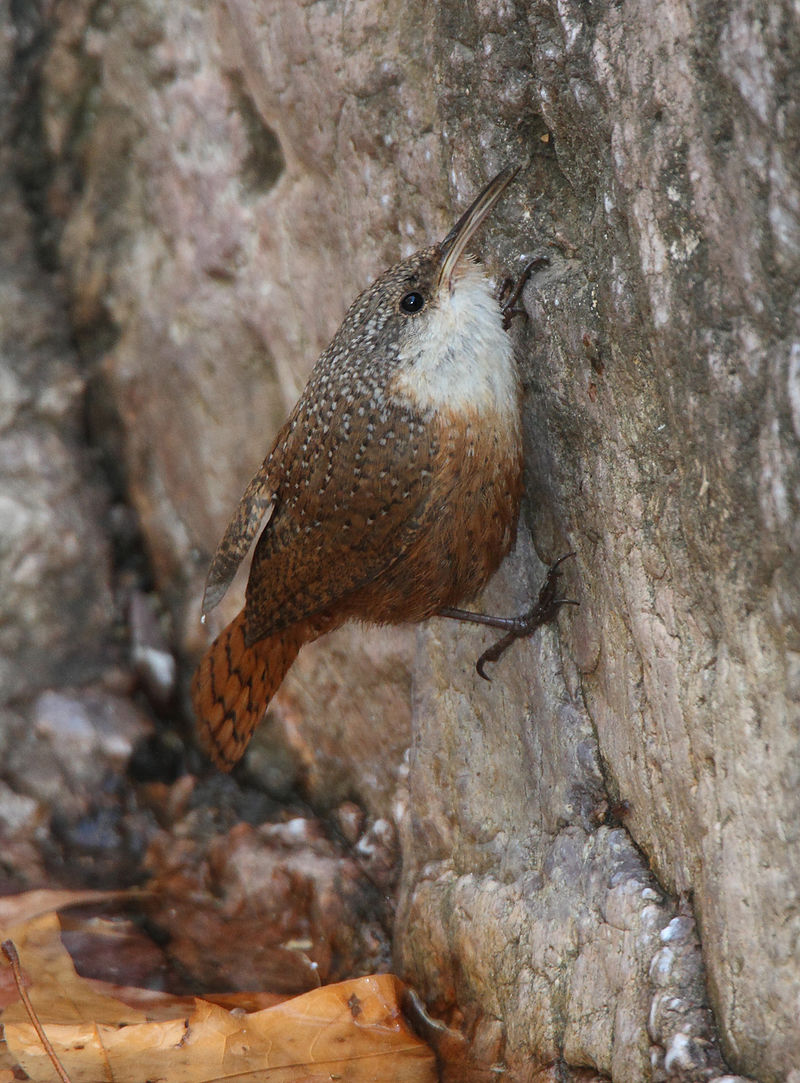
The Canyon Wren is a small songbird that belongs to the wren family, Troglodytidae. It’s native to North America and lives mainly in rocky or arid areas such as cliffs and canyons.
A distinct feature of this bird is its loud song which echoes through the canyon walls – it can be heard from far away.
The Canyon Wren has adapted well to its environment; with drab coloring helping it blend into the rocks, camouflaging itself from predators.
Its diet consists mainly of insects, spiders and snails found on cliff faces or in crevices between rocks.
As there are no other species within its taxon, they do not have any major threats aside from natural occurrences like avalanches or rock slides that could cause habitat loss for them.Scientific classification:
| Kingdom | Animalia |
| Phylum | Chordata |
| Class | Aves |
| Order | Passeriformes |
| Family | Troglodytidae |
| Genus | Catherpes Baird, 1858 |
| Species | C. mexicanus |
Also Featured In: Wrens Species, Most Common Songs Birds that Live around You
31. Verdin
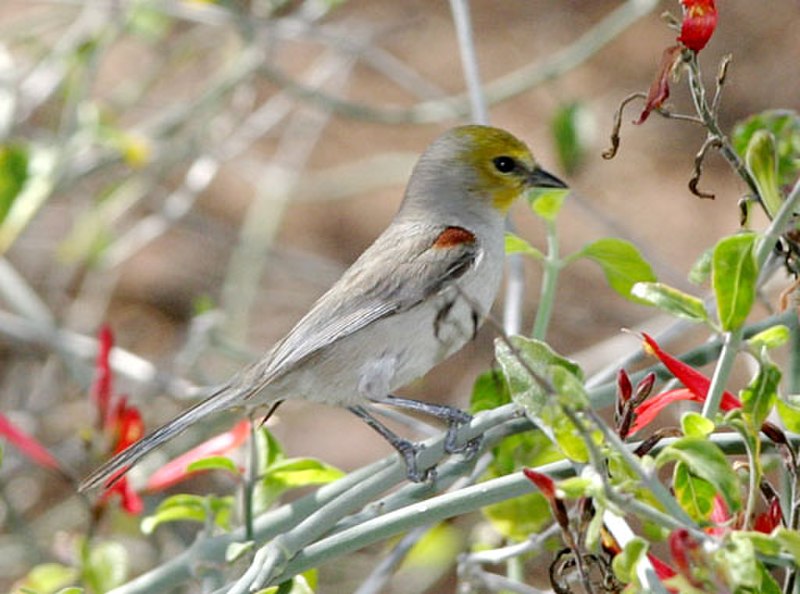
Verdin is a species of penduline tit, the only one in its genus Auriparus and family Remizidae found in North America.
It was formally described by Swedish zoologist Carl Jakob Sundevall under the binomial name Aegithalus flaviceps in 1850.
This small bird has an olive-grey coloration on its head, back and wings while having white colouring around its face with yellowish patches near eyes.
The underside is pale grey with brown tinge while feet are pinkish/brown tinted. Its diet consists mainly of insects which it forages from tree branches or shrubs.
During mating season they build intricate nests made up of grasses and moss lined inside with feathers or fur held together by spider webs usually suspended from thorny trees close to water sources like rivers or streams making them ideal for rearing young chicks before their migration towards south during winter months.Scientific classification:
| Kingdom | Animalia |
| Phylum | Chordata |
| Class | Aves |
| Order | Passeriformes |
| Family | Remizidae |
| Genus | Auriparus S.F. Baird, 1864 |
| Species | A. flaviceps |
Also Featured In: birds of Arizona, Common Birds That Live in Las Vegas
32. Curve-Billed Thrasher
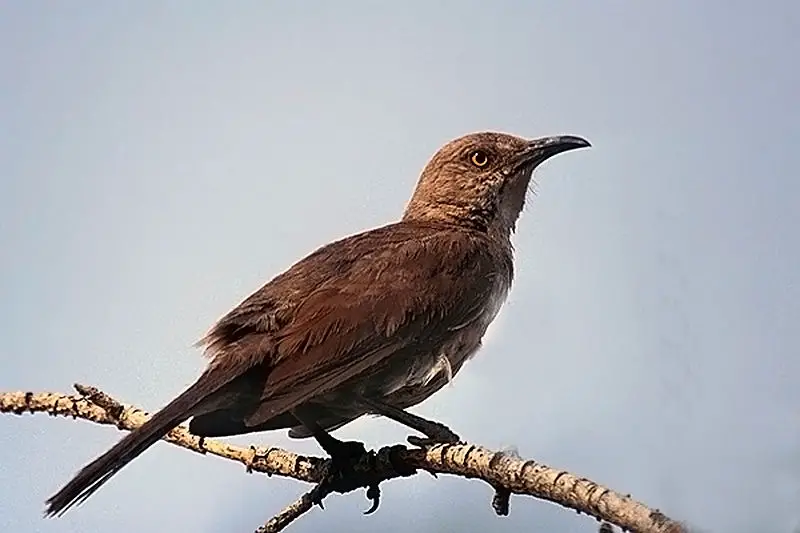
The Curve-billed Thrasher is a medium-sized bird native to Mexico and the southwestern United States. It lives mainly in desert areas, where it can be found foraging on the ground for its insect prey.
Its name comes from its curved bill, which aids in rooting out insects and other food sources.
The species has several subspecies that are geographically separated throughout much of their range; allopatric speciation likely played an important role here as well.
Despite being non-migratory, this thrasher will sometimes travel long distances when resources become scarce or during courtship displays with potential mates.
A successful predator of grasshoppers, beetles and other arthropods, the Curve-billed Thrasher plays an essential role in maintaining healthy ecosystems by controlling pest populations.Scientific classification:
| Kingdom | Animalia |
| Phylum | Chordata |
| Class | Aves |
| Order | Passeriformes |
| Family | Mimidae |
| Genus | Toxostoma |
| Species | T. curvirostre |
Also Featured In: Birds You’ll Find in South Texas , Birds You’ll Find in the Rio Grande Valley
33. Gambel’s Quail
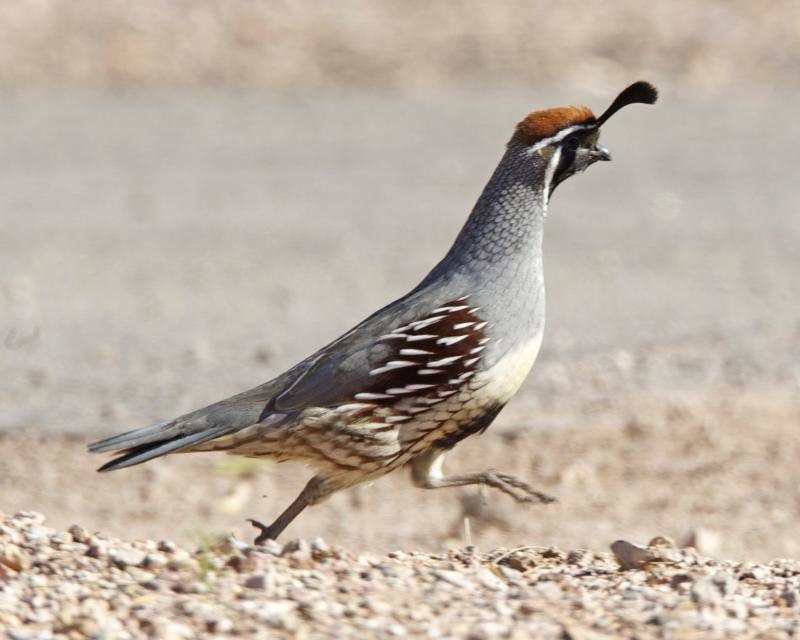
Gambel’s quail is a small bird belonging to the New World Quail family, found in desert regions of Arizona, California and other states. These birds inhabit dry areas with sparse vegetation such as cacti and shrubs.
They are named after William Gambel who explored much of the Southwestern United States during his lifetime.
This species has gray plumage on its body with a white underside and an eye-catching black plume that lies flat against their head when not displaying or calling out for mates during breeding season.
During these times they will also form large coveys (groups) which can range from 10 – 40 individuals.
When alarmed this group usually hides under nearby brush until danger passes – making them difficult to spot even in open terrain due to their camouflage coloration.Scientific classification:
| Kingdom | Animalia |
| Phylum | Chordata |
| Class | Aves |
| Order | Galliformes |
| Family | Odontophoridae |
| Genus | Callipepla |
| Species | C. gambelii |
34. Pyrrhuloxia
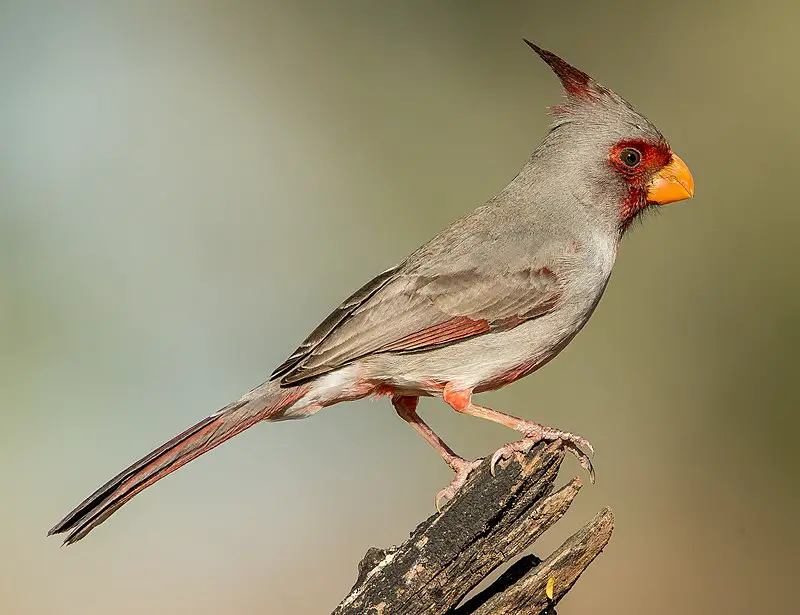
The Pyrrhuloxia, also known as the desert cardinal, is a stunningly beautiful bird native to the American Southwest and northern Mexico.
With its red crest and wings, short stout bill, it closely resembles the Northern Cardinal and Vermilion Cardinal of its same genus.
It has an average size compared to other songbirds in this area at around 18cm long with a wingspan of up to 28 cm wide.
Its diet mainly consists of small insects such as grasshoppers but they will occasionally eat some fruit or seeds too.
The Pyrrhuloxia’s singing ability rivals many birds in that region due to their clear whistles which can be heard from afar on quiet mornings.
The beauty of these birds makes them very popular among birdwatchers who come from all over just for a chance glimpse of one.Scientific classification:
| Kingdom | Animalia |
| Phylum | Chordata |
| Class | Aves |
| Order | Passeriformes |
| Family | Cardinalidae |
| Genus | Cardinalis |
| Species | C. sinuatus |
Also Featured In: Red Birds You’ll See in Oklahoma, Red Birds You’ll Commonly Found in Texas
35. Phainopepla
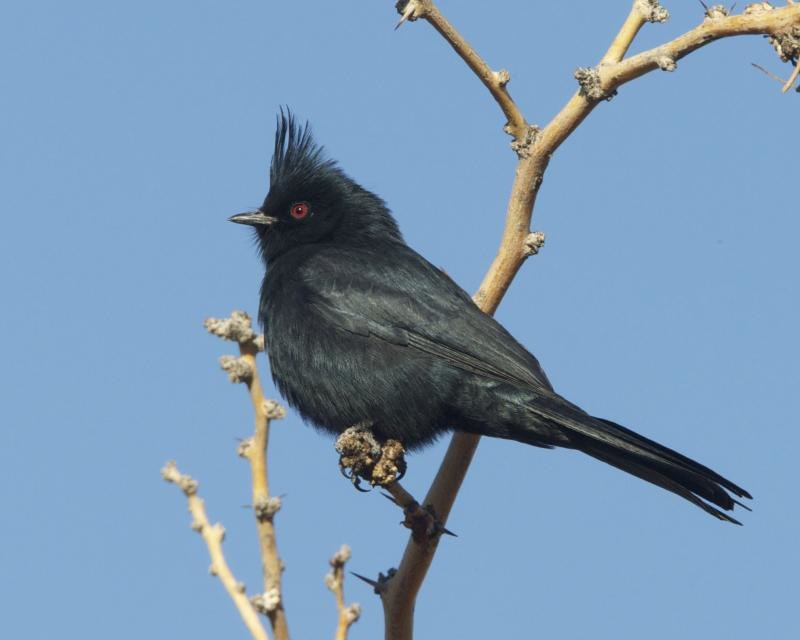
The Phainopepla bird is a stunning species to behold. It has an iridescent black plumage and stands at 16-20 cm long with a noticeable crest and long tail, giving it the appearance of wearing a ‘shining robe’.
This species belongs to the mainly tropical Central American family Ptiliogonatidae, which are known as silky flycatchers.
Its name derives from Greek origin meaning ‘shining robe’ in reference to its distinctive male plumage.
The phainopepla is natively distributed throughout North America, where they inhabit areas such as open woodlands and deserts that provide ample food sources like fruits or insects.
As fascinating birds of prey they have some interesting habits; for example they will often use their beaks to pry off bark while searching for tasty morsels beneath.Scientific classification:
| Kingdom | Animalia |
| Phylum | Chordata |
| Class | Aves |
| Order | Passeriformes |
| Family | Ptiliogonatidae |
| Genus | Phainopepla S.F. Baird, 1858 |
| Species | P. nitens |
36. Montezuma Quail
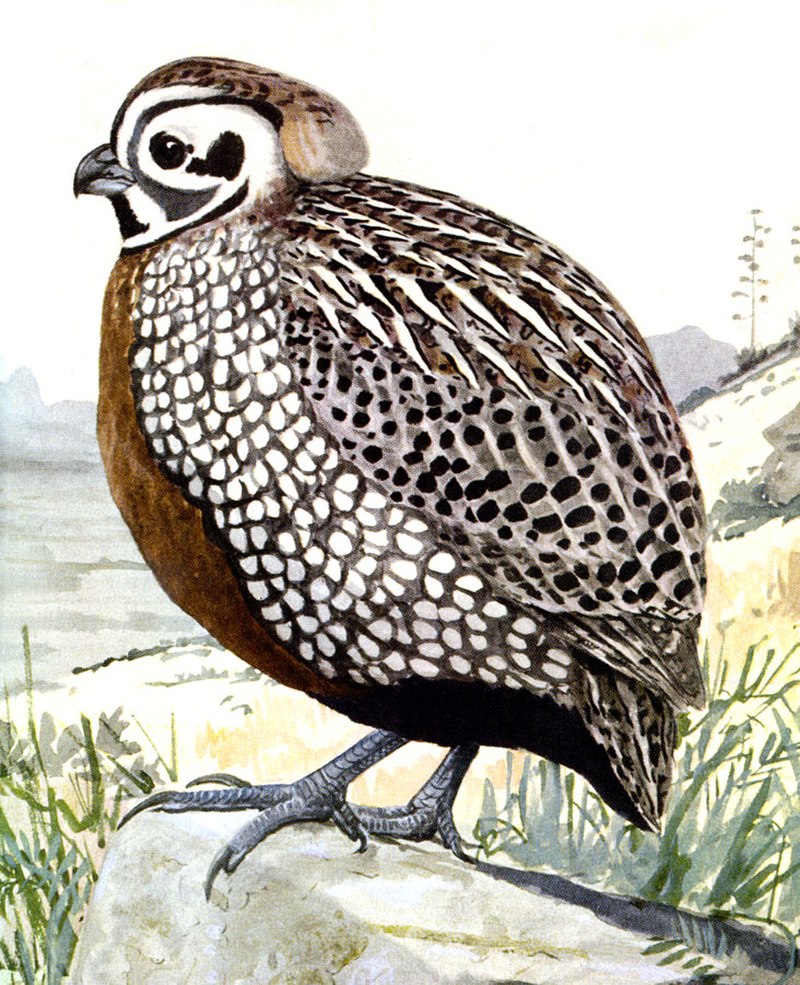
The Montezuma quail, also known as Mearns’s quail, the harlequin quail and fool quail due to its behavior is a stubby New World bird found in Mexico and some parts of the United States.
It was formally described by Irish zoologist Nicholas Aylward Vigors under the binomial name Ortyx montezumae in 1830.
This small secretive bird has striking patterning on male birds which gives it another common name – Harlequin Quails.
They inhabit deserts, grasslands or scrub vegetation for shelter but are shy and difficult to spot even when calling out their distinctive raspy call during mating season.
These birds feed mainly on insects such as beetles, ants along with seeds and other plant matter making them an important part of maintaining healthy ecosystems where they live.Scientific classification:
| Kingdom | Animalia |
| Phylum | Chordata |
| Class | Aves |
| Order | Galliformes |
| Family | Odontophoridae |
| Genus | Cyrtonyx |
| Species | C. montezumae |
Also Featured In: Most Common Oaxaca Birds,
37. Lesser Nighthawk
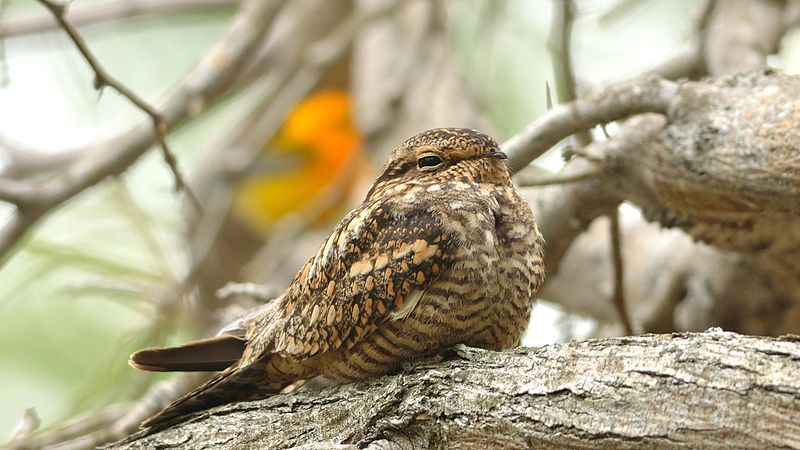
The Lesser Nighthawk is a nocturnal bird found across the Americas. Its dark brown and grey body has white patterning, while its long upper wings are black with a distinctive white bar visible in flight.
The tail is also black with thin white bars, while the underside of its body is buffy-coloured and finely streaked with horizontal lines.
Males have a bright white throat while females don’t; they both share an orange eye rim to complete their look.
During mating season males can be seen performing display flights at dusk over open areas like grasslands or riverbanks to impress potential mates.Scientific classification:
| Kingdom | Animalia |
| Phylum | Chordata |
| Class | Aves |
| Order | Caprimulgiformes |
| Family | Caprimulgidae |
| Genus | Chordeiles |
| Species | C. acutipennis |
Also Featured In: Most Common Birds in Michoacán,
38. Roadrunner
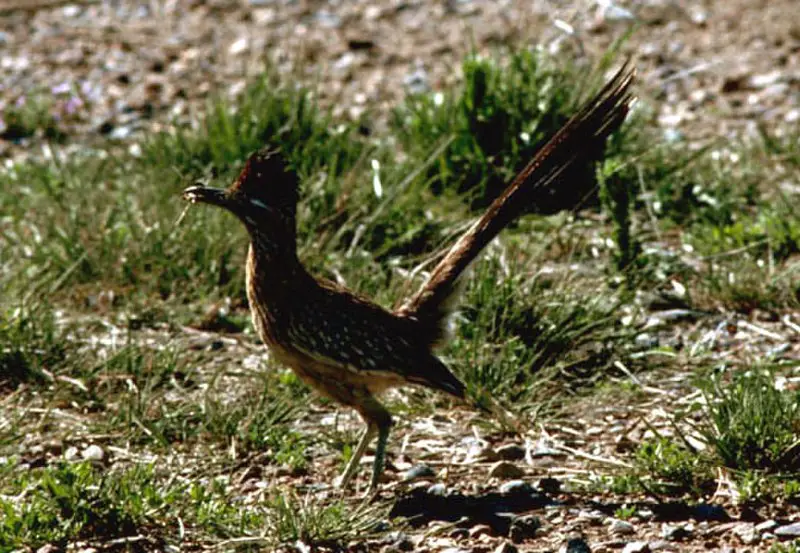
Roadrunners are fast-running ground cuckoos with long tails and crests, found mainly in the deserts of the southwestern United States and Mexico.
They can fly but usually prefer to run away from predators at speeds reaching up to 32km/h.
Their diet consists mostly of insects, lizards and small rodents.
Roadrunners have unique mating rituals where male birds will perform a dance for their mate before they build nests together out of sticks or other materials on low bushes or even directly on the ground.
These birds also make very distinct calls that sound like “beep beep” which is how they got their name – roadrunner.Scientific classification:
| Kingdom | Animalia |
| Phylum | Chordata |
| Class | Aves |
| Order | Cuculiformes |
| Family | Cuculidae |
| Subfamily | Neomorphinae |
| Genus | Geococcyx Wagler, 1831 |
Also Featured In: birds of New Mexico, Birds of Symbolism
39. Scott’s Oriole
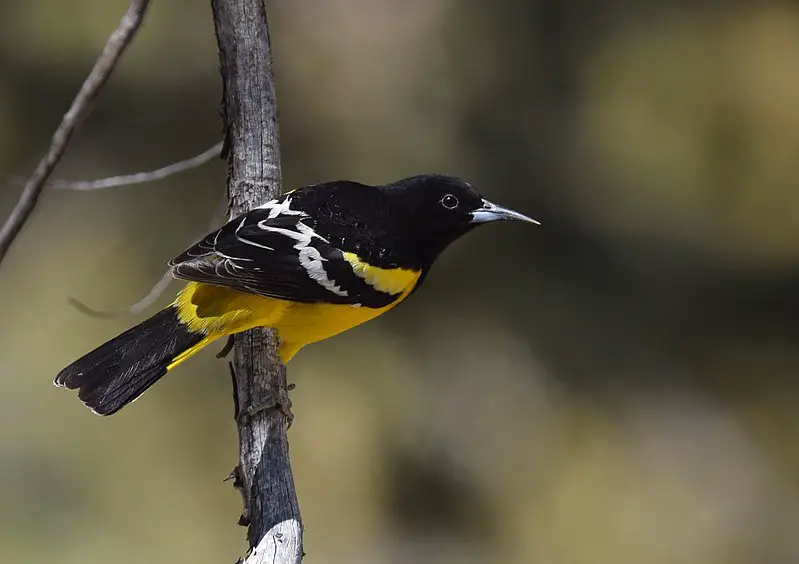
The Scott’s oriole is a medium-sized icterid found in the Southwestern United States, Mexico and Baja California Sur. Named by American soldier and naturalist John Charles Frémont for his friend Robert F.
Scott, this beautiful bird has bright yellow underparts with an orange back and black wings.
Its song consists of long series of whistles that are often likened to the sound of a flute or piccolo.
They feed mainly on insects but can also eat some fruits such as dates and figs from trees like mesquite, palo verde, live oak, sycamore and cottonwood.
This species is common south from Sacramento in California making it easy to spot if you’re lucky enough to be near its habitat.Scientific classification:
| Kingdom | Animalia |
| Phylum | Chordata |
| Class | Aves |
| Order | Passeriformes |
| Family | Icteridae |
| Genus | Icterus |
| Species | I. parisorum |
Also Featured In: birds of Nevada, Common Yellow Birds of Idaho
40. Rosy-Faced Lovebird
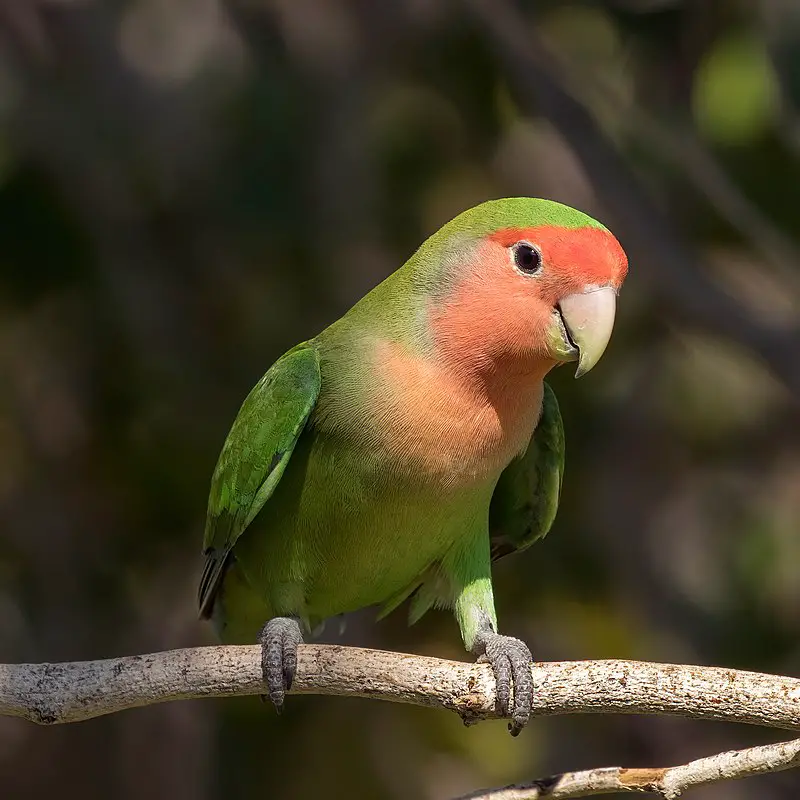
The Rosy-faced Lovebird is a vibrant and social species of bird native to arid regions in southwestern Africa. These small birds are known for their loud chirps which often come as part of large groups in the wild.
They also have wide variation between individuals when it comes to coloration, with some having more rosy hues on their faces than others.
Rosy-faced lovebirds eat throughout the day and enjoy frequent baths – they get most active during sunset where they fly around looking for food or interacting with other members of its flock.
It’s not uncommon to see these little birds playing games amongst themselves.
In captivity, they make wonderful pets due to their intelligence, friendliness and need for companionship from humans or other animals alike; making them great fits into any home environmentScientific classification:
| Kingdom | Animalia |
| Phylum | Chordata |
| Class | Aves |
| Order | Psittaciformes |
| Family | Psittaculidae |
| Genus | Agapornis |
| Species | A. roseicollis |
Also Featured In: birds of green birds, Case Birds that Live in with Us
41. American Kestrel
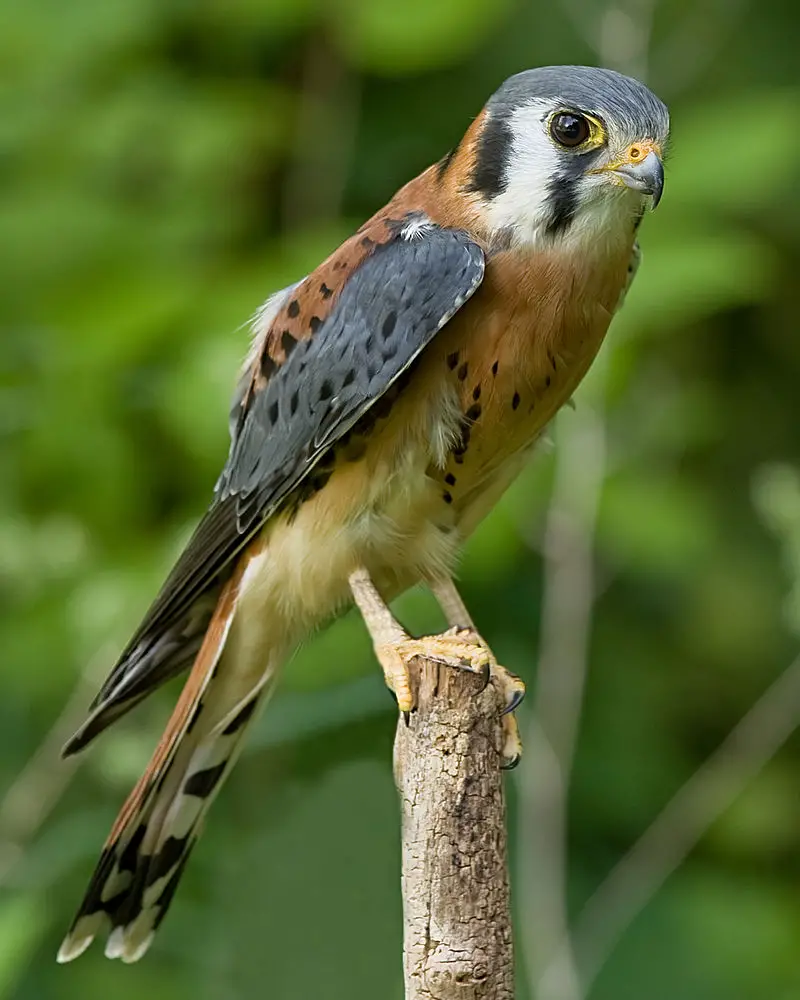
The American kestrel, also known as the sparrow hawk, is a popular falcon species in North America. It is the smallest falcon and can come in different sizes based on subspecies and sex.
Its weight ranges from that of a blue jay to a mourning dove. In addition to North America, this bird species is also found in South America.
There are 17 subspecies of American kestrels, each adapted to different environments.
Although small in size, the American kestrel is a fierce predator, often preying on insects, rodents, and other small birds.
Its impressive hunting skills and stunning coloration make it a favorite among birdwatchers and falconers alike.Scientific classification:
| Kingdom | Animalia |
| Phylum | Chordata |
| Class | Aves |
| Order | Falconiformes |
| Family | Falconidae |
| Genus | Falco |
| Species | F. sparverius |
Also Featured In: Birds That Live in Colorado, Long Island Birds You Should Know
42. Crissal Thrasher
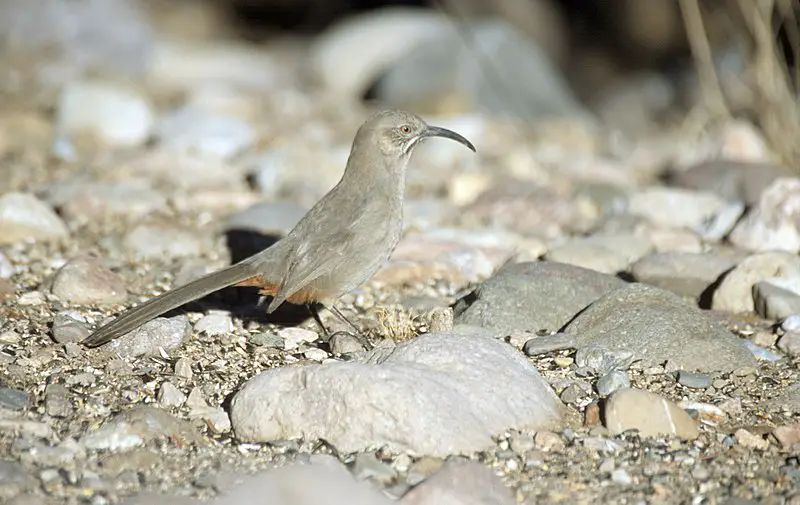
The Crissal thrasher is a sizeable bird that can be found in the Southwestern region of the United States and central Mexico.
It can grow up to 32 centimeters in length and is easily recognizable by its curved beak and dull yellow eyes.
It is a member of the thrasher family and is known for its distinctive singing voice.
The Crissal thrasher prefers to live in dense, thorny vegetation and can often be found in desert habitats. It feeds primarily on insects, but also eats fruits and small vertebrates.
Despite being a common bird in its range, the Crissal thrasher is somewhat elusive and can be difficult to spot due to its tendency to stay hidden in dense brush.
Bird enthusiasts consider the Crissal thrasher to be a beloved and impressive species due to its unique features and behavior.Scientific classification:
| Kingdom | Animalia |
| Phylum | Chordata |
| Class | Aves |
| Order | Passeriformes |
| Family | Mimidae |
| Genus | Toxostoma |
| Species | T. crissale |
43. Bendire’s Thrasher
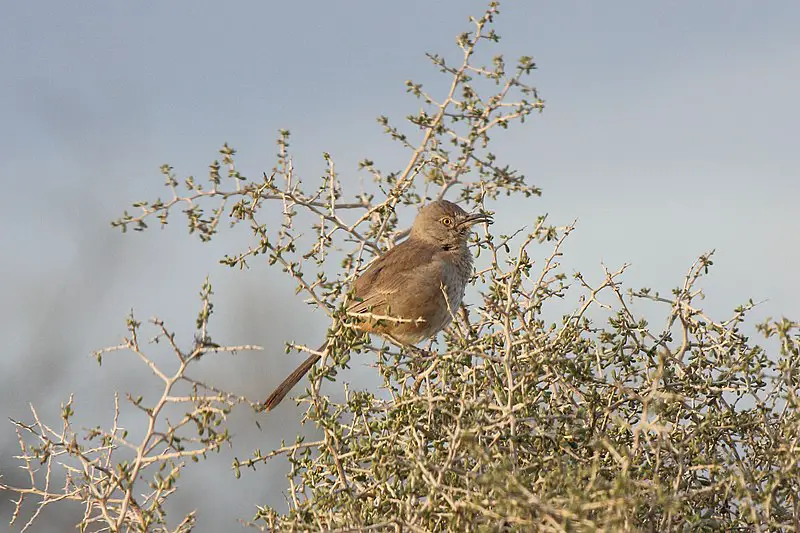
Bendire’s thrasher is a bird species commonly found in the southwestern United States and northwestern Mexico.
This medium-sized bird typically measures 23-28 centimeters in length and has a long tail and medium-sized bill.
The bird’s upperparts are grayish-brown in color, while its underparts feature faint dark streaks on paler shades.
One of the bird’s distinctive features is its bright yellow eyes and often pale base of the lower bill.
Bendire’s thrasher is known for its unique and beautiful song, which is often heard during breeding season.
This bird species feeds mainly on insects and fruits, and can be found in various habitats, including desert scrub and chaparral.
Despite occasional threats from urbanization and habitat destruction, populations of Bendire’s thrasher remain stable in many parts of its range, largely thanks to conservation efforts.Scientific classification:
| Kingdom | Animalia |
| Phylum | Chordata |
| Class | Aves |
| Order | Passeriformes |
| Family | Mimidae |
| Genus | Toxostoma |
| Species | T. bendirei |
44. LeConte’s Thrasher
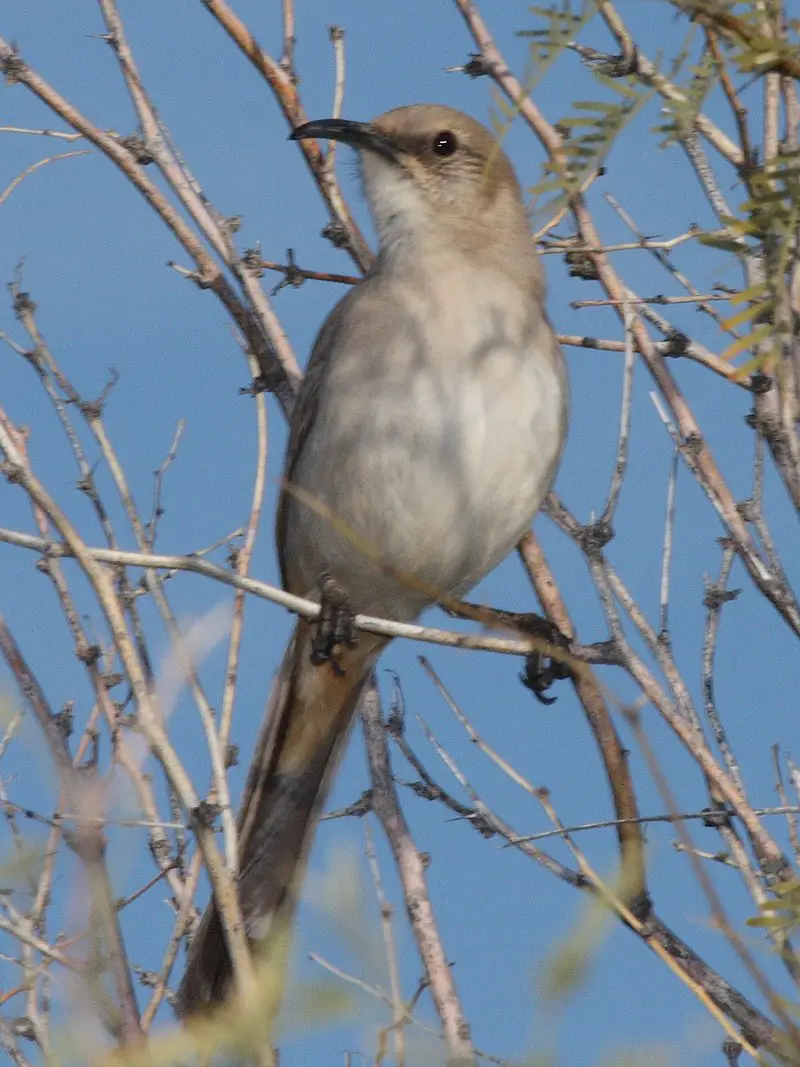
LeConte’s thrasher is a bird that is commonly found in the southwestern United States and northwestern Mexico.
It typically resides in deserts with sparse vegetation, where it can easily blend in with the sandy soils.
The bird is known to be non-migratory and is found in the same territory every year. Sadly, this species has been declining in certain areas, particularly in California.
Despite its pale appearance and preference for arid habitats, the LeConte’s thrasher is a resilient bird that has adapted well to life in the desert.Scientific classification:
| Kingdom | Animalia |
| Phylum | Chordata |
| Class | Aves |
| Order | Passeriformes |
| Family | Mimidae |
| Genus | Toxostoma |
| Species | T. lecontei |